#my centered icons era was short lived
Text
I JUST UPDATED MY TUMBLR APP I CANT BELIEVE THEY FIXED THE THING WITH ICONS GETTING STRETCHED OUT AND HUGE RIGHT AFTER I EDITED ALL MY ICONS TO BE CENTERED WITH A TRANSPARENT 540PX CANVAS TO PREVENT ICONS GETTING STRETCHED OUT
#IVE BEEN HOLDING OUT FOR LIKE 3 YEARS AND WHEN I DO THE JUMP THEY FIX IT ?????? HELLO ????#IDK ITS ALMOST 4 AM IM FULL OF REGRET AND BETRAYAL @STAFF ITS ON SIGHT HOMIES 🔪#im gonna be honest with yall i will prolly revert to my icons not being centered and stuff its honestly just prettier#also browsing through icons is a complete nightmare#HEAVY SIGH#my centered icons era was short lived#literally not even two weeks#no bc i can hear kastor getting ready to bonk me in the head for being annoying about this IM SORRY BBY#anyways...... lets batch all of my icons on photoshop again#ooc.
10 notes
·
View notes
Text
My Eras Tour Fits, One For Each Era!
also pls bear with me on this, I am boring and dont rly know how to dress, so these may not be that cool
obligatory tagging the people who asked for it + swiftie mutuals: @dybalaispretty, @lonely-salamander, @rainingmbappe, @liverpool-enjoyer, @purefractals, @tam-is-blogging, @charlesluvr !!!!
General Swiftie Fit:
I could only put 10 images in this post so I just wanted to describe my general swiftie concert outfit, which would be the iconic 22 outfit, except with full length sweats not tiny shorts because like. I do not have beautiful slender legs like Mrs. Swift.
Now, onto the Eras:

I just wanted to go for a simple country look. In Swiftiedom, green is the official color of debut, so I went for some supercute green cowboy boots and a simple cowboy outfit! Underneath the plaid shirt I'd imagine I'm wearing one of those "Who's Taylor Swift Anyways? Ew." shirts. I know that's from 22 but I don't care lol.
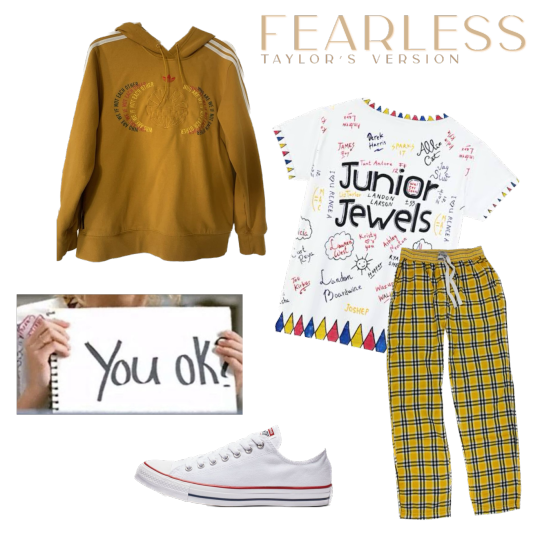
Yeah don't judge me. I would pull up with the notepad as well, I would write the chants on it cuz I don't like shouting. I wouldn't wear the hoodie unless it got super cold, but I still made sure the hoodie was on theme! Also I'm aware that's not the pajama bottoms she wore in the vid, I wanted them to be fearless-colored (golden yellow)!

Since I couldn't wear the iconic Speak Now dress (way too impractical to wear to a concert LOL) so I went for like, a groom's look? I just realized I forgot to put trousers in this. Well they would be a dark purple, much darker than the shirt, almost black. I went for white gloves because it just gives me bridal vibes idk? Like a groomsman. This fit would look perfect beside the Speak Now dress, which is what I was going for.

Yeah I won't waste y'all's time. I would wear that exact fit. It is the best costume I've ever seen. I just wouldn't wear leggings like she does because once again I don't have legs for days.

I wanted something that would BLIND ANYONE WHO LOOKED AT ME!! BECAUSE THAT'S THE VIBES OF 1989!!! Keep dancing and don't let ANYONE tell you you're too much! Be goofy and silly who gives an F!!!

Yeah don't judge me. Reputation is my favorite album. I would 100% go ham and go full bad boy biker with this one! The shirt says "and in the death of her reputation, she felt truly alive" which is the quote I live by. I think I would slay this fit. Too bad I have zero (0) money.

This isn't exactly what I'd wear. 1) the shirt would have even BOLDER colors. As well as the jacket. This is basically a You Need To Calm Down fit... I love that song so much it makes me wanna dance. Also, my jacket would say "The Man" on the back. I would also do that lover makeup thing with the eye heart.

"who brings headphones to a concert" well DUH i'm not wearing them. Sometimes we sacrifice logic for the sake of the serve! Also, my stuffed husky, Dustin, is part of this fit, but I can't get a good enough pic of him. Just know he is part of this, I wanted this to give "I'm still in bed" vibes, cuz that's what folklore is to me as an album? Idk, it just gives me that, "I wrote this while nestled under the covers" feel.

This is just meant to replicate what Taylor already wears on the album cover. Also, I would have a champagne glass.

And last but DEFINITELY not the least, my Midnights fit! I also designed this as a general Eras fit, because tbh the Eras aesthetic is kind of the Midnights one too, if that makes sensee? I wanted this one to give the vibes of that You're Losing Me line, "I'm the best thing at this party, I wouldn't marry me either". Clearly stylish, but meant to be in the back of the party, not the center.
#shitpost#taylor swift#eras tour#debut#speak now#fearless#red#1989#reputation#fearless tv#fearless taylor's version#red taylor's version#lover#folklore#evermore#midnights#outfits
35 notes
·
View notes
Text
FORGOTTEN LIVES: Robert Banks Stewart

Before we begin! Remember to get a copy of the Forgotten Lives Omnibus at this link! You've got until the end of August to get a copy before preorders end, so make sure to grab a copy!
It was in 1970 that we first saw John Pertwee take center stage as the Doctor, now trapped on Earth and cooperating with UNIT as he continued to fight against aliens from another world. It was this era that saw iconic locations such as Peladon and iconic villains such as the Master make their footprint on the franchise. Conversely, Philip Purser-Hallard brings us a Doctor cut from the same cloth, showing us another landlocked Doctor as he tangles with a new nemesis.
Robert Banks Stewart (1931-2016) has a small but notable footprint on Doctor Who, having written Terror of the Zygons and The Seeds of Doom. He also wrote for other popular shows such as The Avengers (not the Marvel one) and Adam Adamant Lives!
There is little I want to discuss about Banks Stewart himself - instead, I want to focus on Purser-Hallard and the era he's formed for this Doctor. You'll notice when reading the book that certain Doctors reflect later eras or formats of the show to give themselves unique ground, which is no different here. Purser-Hallard places this Doctor in the middle of the Second World War, working with the British Government. Purser-Hallard lists the Basil Rathbone Sherlock Holmes movies as one of the inspirations behind this Doctor and you can feel that in the writing, as the Doctor investigates a unique case in House of Images involving Laurel and Hardy, with much more lying beneath the surface than first appears.
In my previous post, I argued that this Doctor still hadn't reached proper sci-fi however I now feel that's wrong. While he does encounter some sci-fi elements, it's more apt to say his character closely ties itself with the supernatural. There is no better evidence to this than the nemesis that this Doctor faces - where he will someday know the Master, here we meet the Magus. The influence of the Master can be seen quite clearly, with the Magus possessing mesmerizing abilities that come into conflict with the Doctor's more practical skills. I personally found it a surprise to see the Doctor presented with a proper rival so early on, but understanding the intention of the Magus to act in a Moriarty-role made the inclusion much more logical.
Paul Hanley's design of the Banks Stewart TARDIS also took a clear alchemist inspiration, with a more rustic feeling that feels very Di-Vinci in design. Although they make very small appearances in the era, this Doctor also appears to have an owl companion.

Now is a good time to cover one important story - Retrogenesis. Unlike many other authors, Purser-Hallard did not write a full short story for the second book and focused his efforts elsewhere. Retrogenesis is a story that covers an alien race called the Kelda, along with their encounters across all eight Morbius Doctors. As the editor for Forgotten Lives (and who we have to thank for these fantastic books), Purser-Hallard has more intimate knowledge that allows him to cover each era. The story of the Kelda is told in snippets, only two pages in length, but I'd argue it best encapsulates what Forgotten Lives is - a snapshot into their lives, left for you to continue.
For more insight into the creative process of every author that worked on Forgotten Lives, you can go to @forgottenlivesobverse and find interviews from everyone involved across the books. If you're looking for insight on how the outfits were designed, you can go to Paul Hanley's Patreon and find what went into designing each Doctor.
Look forward to these four stories as the Doctor works through the Second World War, facing off against demon dogs and comedy legends:
HOUSE OF IMAGES by Philip Purser-Hallard:
THE HOUNDS OF WAR by Kenton Hall:
RETROGENESIS (Part Two) by Philip Purser-Hallard:
THE ROSEWELL INCIDENT by Matthew Kresal:
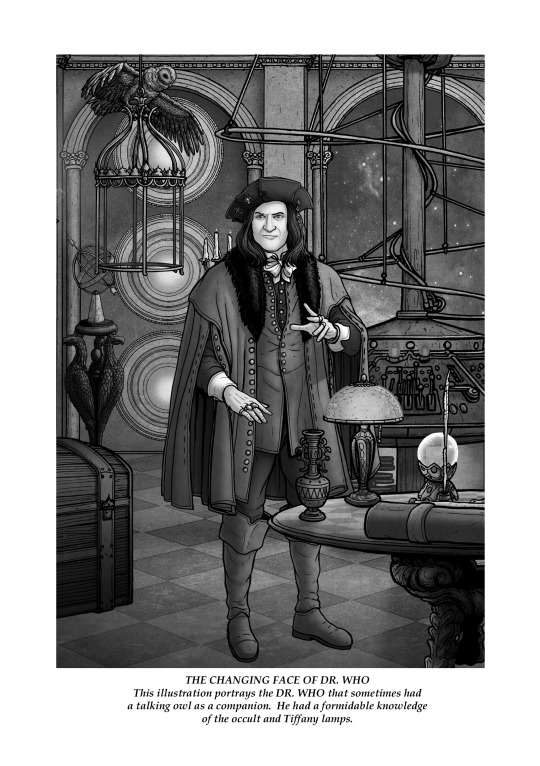
Tomorrow we'll be covering the Christopher Baker Doctor, where we'll follow a Doctor travelling with his children, taking a cut from the TV Comics. I'll also give more personal opinions on a story from the second book, so look forward to it!
#forgotten lives obverse#forgotten lives#obverse books#doctor who#the brain of morbius#robert banks stewart
14 notes
·
View notes
Text
Seeing Blue
I grew up in a very different era. Different stores. Different cultural values. Different everything. If I were able to go back to the 1960s, the decade of my youth, I wouldn’t recognize the place, so much has changed since then.
And one of the biggest most popular retail chains back then was Kmart. It was Walmart long before Sam Walton could gather enough momentum to expand out of Arkansas. The chain traced its roots to founder traveling hardware salesman S. S. Kresge, who opened his first store in 1897 with a partner. The shops, which soon spread across the US, were part of what was then known as the “five and dime” category, meaning cheap stuff.
It was in 1962 that his successor opened the first large-scale retail store, a prototype of the big box phenomenon that would come decades later. They were suburban, whereas the original Kresge stores tended to be center city. Kmart quickly became a retail icon.
There was a shiny new Kmart not many miles from where my family lived at the time, which was the south suburbs of Chicago. My Dad the Accountant always loved a bargain, and had no problem going there in search of one. Mom was enticed by short-term promotional offers that helped her replenish household needs, as well as personal products. My brother and I went along for the ride.

It was Kmart’s signature promotional stunt that probably painted a black eye on the company, though. Their Blue Light Special caused customers to get in an uproar, but also became synonymous with inexpensive junk.
Let me paint a word picture for you. At a seemingly random time, a shop employee would start walking the aisles with a special cart that had a revolving blue light mounted atop a pole. This caught shoppers’ attention, because no one knew where he was going. They just knew that a free for all was about to happen. At the ordained time and location, he would stop, and a voice would come over the loudspeaker: “Attention Kmart shoppers…”
And the deal was announced. “Pantyhose in Aisle 8 for 99 cents!” The women would go wild, pawing over nylon stockings as if this were a Black Friday sale on Xboxes. My brother, Dad, and I were left scratching our heads wondering what we were seeing, primal instinct propelling these women to fight as if they would never own another pair.
It scarred me for life. But then again, maybe it helped shape my never ending fascination with consumer behavior. I still don’t understand that scene, though.
Anyway. I have digressed terribly. Let’s skip forward to the 21C, which found a struggling Kmart and Sears merging in 2005. Both chains had seemingly outworn their welcome on the American retail landscape. Eddie Lampert and his hedge fund orchestrated the unlikely marriage, ostensibly so he could invest vast sums of money in both and make them more competitive again.
It quickly became apparent that Lampert was not at all interested in retail, but rather the land beneath it. The two chains had massive amounts of valuable real estate, and he started closing stores so they could be repurposed or demolished for other purposes. By 2019, there was little left, and in a fit of bankruptcy—long after he had extracted the value—he sold it to Transformco in what was probably the dumbest purchase ever. Unless, of course, Transformco thought it could squeeze a few more drops out of the orange.
Today, there are 11 Sears stores left in the continental US, and one in Puerto Rico. And Kmart—God bless them—is about to close its one remaining full-size store next month. All that will be left is a seriously downsized Kmart in Miami, and stores in the US Virgin Islands and Guam (because there’s no competition on those islands).
Fans of old retail are mourning, although we all knew it was just a matter of time. Amarillo lost its Kmarts years ago, as did the outlying towns. I remember the one in Clinton Oklahoma closing not long ago, one of the long-term survivors. You can always tell an old Kmart store, even though the company was always swift to remove all signage and vestiges of branding. About the best you could hope for is what we call a “label scar,” meaning the fuzzy, ghostly imprint of lettering when the rest of the building had faded around it through the years.
I am pretty sure that most of my students have not experienced a Kmart, unless you grew up near one of the rapidly dwindling number of stores during the last 20 years. They were hideous, typically in disrepair, with merchandise scattered haphazardly throughout. It wasn’t just cheap. It reaked of cheap. “Blue Light Special” had come to characterize the whole place, not just a good deal over on Aisle 8.
I could be callous and say good riddance, but I recognize that Kmart served its purpose. In many regards, Dollar General and the other stores of this type are carrying on the tradition, although on a much smaller scale, and without colorful lights. By comparison, Walmart looks like Saks 5th Avenue, and Target is Nordstrom.
And yet I still remember the carnage of women gone wild that one day. Some memories you simply cannot erase.
Dr “But I Wish I Could” Gerlich
Audio Blog
0 notes
Text
youtube
Appleseed - "Mile High Express"
Big Beat
Song released in 1997. Compilation released in 1998.
Big Beat
Plays: N/A on Spotify // 10.5K+ on YouTube
Alright, folks, I really hope that I'm able to spark some shit into motion with this post here, because the way the general vibe is right now…well…things are feeling quite unprecedentedly fucked. So, I think it would just be in all of our best interests if we agreed that it was high time for us to immediately leap into our much-needed big beat revival era, because, I don't know about you all, but whenever I hear a quality big beat tune, my spirits seem to get raised pretty instantly 😎.
Now, I don't have nearly enough of this stuff myself, and because it took me such a long time to figure out exactly what this music was even called in the first place, I feel like I should briefly explain what it is and where it came from.
Big beat was a Brit-centered phenomenon that took place between the mid-90s and early 2000s and was a subgenre of breakbeat. Like breakbeat, it relied on a sampled drumbeat-or-break to form the base of its rhythm, but beyond the drums, the rest of it was also significantly sample-based too, incorporating all sorts of instrumental sounds off of 60s and 70s records, and often an old school hip hop lyric as well, to create dance tunes that just had this…rather big sound to them. The undisputed king of this stuff's always been Fatboy Slim, but Chemical Brothers and The Prodigy are definitely up there as well, and others have made significant contributions too, like The Wiseguys with "Ooh La La" and "Start the Commotion," Basement Jaxx with "Where's Your Head At," and Moby with "Bodyrock."
And the thing about this music is, even though not very much of it actually managed to chart all that highly Stateside, and you couldn't really even find much of it on radio or MTV either, it was still nevertheless pretty much everywhere else, coursing through countless videogame, film, and TV advertising soundtracks. Big beat's retro-present nature, as it lightheartedly revived fun and vintage sounds on top of drumbeats that still sounded modern enough, seemed to fit perfectly during such a sunny, 'end-of-history' time when people were genuinely and very naïvely excitedly awaiting a technologically advanced, Internet-dominated future that was inevitably going to only transform our society for the better 🥴. Optimism abounded for a period of new, democratic enlightenment that was fast-approaching and its mass-appealing party soundtrack seemed to be comprised of a whole lot of big beat flavor, a forward-looking genre in and of itself that showed what people were capable of creating by cleverly crafting their own groovy dance collages primarily out of various sonic bits that'd been recorded decades prior and largely discarded.
So, with that lengthy preamble out of the way, I've got a total fuckin' big beat banger for you all today from a little-known British trio called Appleseed, whose most popular song, "Mile High Express," was used in an Adidas ad in the States in 1998 because Adidas couldn't get the proper license to use Fatboy Slim's now-iconic "Right Here, Right Now" instead, which ended up being used for the ad overseas.
youtube
Appleseed first debuted in '95 with a 12-inch on a very short-lived London label called Naked, but then in '97, they were on the Middlesex-based Kingsize, who themselves were pretty new too, but seemed to have a better capacity to release stuff on a regular basis. And it was through them that Appleseed would put out their only album, Kick It Till It Breaks, which is where you could find "Mile High Express," before it was issued as its own 12-inch single in '98.
So, sounding like a Fatboy Slim track itself that would equally slay at any sun-shining outdoor gathering or breakdance exhibition, "Mile High Express" basically has five essential elements to it that make it dope. One, a punchy, boom bappy drumbeat; two, a short, killer, looped-up sample from an early 1970s French children's record that's responsible for the underlying piano sound; three, a large helping of squealingly lively and extensively freewheeling joy on a Hammond B3 organ; four, some bells; and five, a sampled, catchy line off of New Jersey rap group Lords of the Underground's 1993 song, "Lord Jazz Hit Me One Time (Make It Funky)":
Watch me scratch it in your brain!
Put all this together with a bassline that mimics the melody of the French children's sample, some radiating ambience, and a brief, little bridge, and you've got yourself quite an irresistibly sweet bop on your hands 👍.
Because Brits seemed to be far more accepting of instrumental music in the first place, a whole lot of dance material was able to commercially succeed there, providing a much more fertile ground for big beat itself to flourish too. On a mainstream level, we only caught a fraction of that wave here in the States, but given how inherently carefree and upbeat this music tended to be, I think we're due to force its comeback…right here, right now…in a way that eclipses the impact that it had originally left, so we can start to be spiritually lifted a mile high out of what's been feeling like a rapidly accelerating downward spiral into a pit of horror. Bring back this quintessential electronic dance sound of the turn-of-the-millennium summer!
1 note
·
View note
Text
Week 10 : Gaming Communities, Social Gaming, and Live Streaming
hi guys! this week we will dive into the vibrant world of gaming communities, the joys of social gaming, and the thrill of live streaming. whether you're a casual gamer, a competitive pro, or just love watching others play, there's something here for everyone. let's get started! 🚀

The Evolution of Games
Before the internet, smartphones, and cell phones became commonplace, and starting in the late 1970s, computer nerds at universities like MIT would sneak into the computer lab and learn how to do programming. Atari (founded by Nolan Bushnell) created the first basic video games, such as Pong, a table-tennis themed video game. (Teicholz, 2020) In addition to producing its own games, Atari founded a whole new industry centered around the "arcade," and soon, arcade games could be found in pubs, bowling alleys, and shopping centers all over the world. (Chikhani, 2024)


Game cartridges eventually replaced Nolan Bushnell and Atari game systems, after Nintendo, including Donkey Kong and Mario, was developed in Japan.

The advent of home consoles in the 1980s and 1990s, like Nintendo and Sega, brought gaming into living rooms worldwide. Suddenly, gaming was no longer confined to public spaces—it was an activity that could be enjoyed at home, alone, or with friends and family. This era saw the rise of iconic franchises such as Mario, Zelda, and Sonic, which have left an indelible mark on popular culture.
Gaming Communities: Where Friendships Level Up!
Gaming communities are the heart and soul of the gaming world. From massive online forums like Reddit, Steam, and Twitter to Discord servers, these spaces are where gamers connect, share tips, and enjoy their favorite games. Communities have an important role in bringing together people of all ages, nationalities, and cultural backgrounds, basically everyone all around the world! Games' virtual worlds erase barriers and offer easier ways for people to connect. (Games, 2023)
Social Gaming: Play Together, Stay Together
Gaming is no longer a solitary activity. Social gaming brings people together, no matter where they are in the world. Team up with friends to take on challenges and quests. It's not just about winning; it's about the journey together.
I think Stardew Valley is the right example for this!

Stardew Valley produced by Eric Barone, is basically a game where you're a young person who quits your boring corporate career to start afresh on your grandfather's run-down farm. As days blend into days and seasons into seasons, Stardew Valley overwhelms the players' stimulus-reward system with an endless stream of short-term quests. The objective is, in a sense, anything you want it to be. (Singal, 2016)

Back to the main point, there's no need to set up a server for multiplayer. Just invite your friends online through whatever platform you're on. When you're on the main menu, pick co-op to decide if you want to start a new farm or join your friend's farm. (Randell, 2021) Easy peasy right?
I co-op a farm with my cousins and since we live in different houses, we use discord to communicate! this is me btw hehe

Live Streaming: The New Frontier of Entertainment
Live streaming has revolutionized the way we consume gaming content. Platforms like Twitch, YouTube Gaming, and Facebook Gaming offer endless entertainment and a chance to interact with your favorite streamers and for streamers to connect with their audience.
This setup lets people connect directly, making everything feel real and personal. Thanks to the internet, anyone can watch or stream live stuff, no matter where they are. It breaks down borders and gives us a huge variety of things to check out. (Carter, 2024)
It also gives content creators a cool new way to make money from their content. They can earn cash through ads, sponsorships, selling merch live, or even virtual tip jars. Here's an example for you!
But hey, let’s talk about something important: gaming isn’t always sunshine and rainbows. Sometimes, they can get pretty messy. You know, all that toxic behavior and bullying? It’s like a dark cloud hanging over things. Competition, controversies, and the whole cloak of anonymity online can stir up some serious drama. We’ve got to make sure our gaming hangouts are safe and respectful places for everyone. That means standing up to toxicity and working together to build a positive vibe. After all, gaming should be about fun and connecting, not tearing each other down.
Gaming communities, social gaming, and live streaming have transformed gaming into a rich, social experience. So, get out there, join a community, play with friends, and maybe even start your own livestream! The world of gaming is more connected than ever, and it might be waiting for you.
that's all from me! as usual, meet you in my next blog? (о´∀`о) meanwhile, drop your favorite gaming communities or streamer recommendations, i would like to hear from you guys! thank you, xie xie, kamsahamida, arigato!
References:
Carter, T 2024, ‘What is live streaming & how does live streaming works?’, What is Live Streaming & How Does Live Streaming Works?, viewed 19 June, 2024, <https://www.zegocloud.com/blog/what-is-live-streaming>.
Chikhani, R 2024, ‘The history of gaming: An evolving community’, TechCrunch, viewed 19 June, 2024, <https://techcrunch.com/2015/10/31/the-history-of-gaming-an-evolving-community/>.
Games, B 2023, ‘Gaming communities: The rise and impact of gaming communities on the world of video games’, Medium, Medium, viewed 19 June, 2024, <https://bggames.medium.com/gaming-communities-the-rise-and-impact-of-gaming-communities-on-the-world-of-video-games-1fec152f649f>.
Laura May Randell, SH 2021, ‘How to play co-op - stardew valley guide’, IGN, viewed 19 June, 2024, <https://www.ign.com/wikis/stardew-valley/How_To_Play_Co-Op>.
Singal, J 2016, ‘How a first-time developer created Stardew Valley, 2016’s best game to date’, Vulture, Vulture, viewed 19 June, 2024, <https://www.vulture.com/2016/03/first-time-developer-made-stardew-valley.html>.
Teicholz, T 2020, ‘Playing with video gaming culture’, Forbes, Forbes Magazine, viewed 19 June, 2024, <https://www.forbes.com/sites/tomteicholz/2020/09/09/playing-with-video-gaming-culture/>.
0 notes
Video
undefined
tumblr
The Making (and Re-Making) of Timothée Chalamet
BY DANIEL RILEY / PHOTOGRAPHY BY RENELL MEDRANO
He found superstardom and artistic acclaim instantaneously. Now, with unique candor, the actor of a generation reveals what it’s like to come of age in our very upside-down era.

The day after the Oscars in 2018, everything that had changed, changed back again. Timothée Chalamet had spent the previous months becoming known. He had acted in a film, Call Me by Your Name, which was critically acclaimed as well as an instant object of cultish admiration—and his performance had made him, at 22, the youngest person nominated for best actor in 80 years. He had, simultaneously, been transformed into the rarest of pop confections—fawned over by younger women, older men, and every demographic in between. And he had traveled without pause on the awards circuit since early autumn, back and forth from New York and Los Angeles, practically living out of the first-class lounge and the lobbies of the Bowery Hotel and the Sunset Tower.
But the day after the Oscars, the moment the clock struck midnight and his carriage turned into a pumpkin, Chalamet was right back where he'd been before the whole fantasy had begun: in New York, with no credit card, no apartment, and no longer any structured demands on his time and attention. Outsiders who had witnessed the arrival may have regarded this 22-year-old as being in possession of wealth and clout, but he was suddenly back on his own dime, which amounted to maybe five or six dimes, reticent to stay with family and friends whose lives he felt he was disrupting with all his new baggage. Of course they couldn't possibly comprehend the chemical reaction that had just transpired. They were still hydrogen and oxygen, and Timothée Chalamet was all of a sudden water.
And so, for three weeks, he disappeared into the wallpaper of the Lower East Side. Specifically, the wallpaper of a little apartment that the French street artist JR kept for visiting collaborators. Chalamet holed up against the ugly New York weather of late winter, and did the only thing he could think to do: learn lines. The King would be his first film since his pivot into fame, and he was anxious to get back to acting after such a long stretch of merely talking about acting. Even more, he needed to blot out the unrecognizable icon the internet was already beginning to make of Timothée Chalamet.
I met Timothée for the first time at the onset of that initial blush of fame, when all of us were being introduced to an actor who had both rare talent and the un-engineerable it that chings like an audible sparkle off a jewel in a cartoon. I wrote a story for this magazine about that first chapter in the arrival of a film star. This is the second chapter, the story of what's happened since. It wasn't evident yet, but those three weeks in New York in 2018 were the starting line of what would amount to a 30-month stretch of four new films, two new Oscar campaigns, some refreshing romance, an incessant awareness of the confusing image of himself as—what else to call it?—an emerging global movie star, and a constant concerted effort to figure himself out as both a young actor and a young person in the unceasing spotlight.

This summer, we were talking about all this on a little screened porch out back of a modest cabin in Woodstock when Chalamet recalled those three weeks. “My world had flipped,” he said. “But if I kicked it with my friends, things could still feel the same. I was trying to marry these two realities. But I don't even think I knew that was what I was doing. That dissonance was real. And thank God. Because I feel like if I'd caught up to it immediately, I would've been a psychopath or something.”
Out on that porch, I asked him a version of the same question over and over: What had the last two and a half years been like for him, as a human being? His response was a multi-hour monologue that I would characterize as: intense. He expressed unadulterated gratitude for his great good fortune. But he also expressed confusion and tension. He is firmly in a moment when he is concerned that everything he says or does or thinks will look or sound wrong. He backtracked a lot (“Wait, let me try that again”). He jumped on and off the record (“Sorry, sorry, sorry, this is just for you…”). It was important for me to know, he said, in order to communicate the context of his experience, if not the specifics.

.
“I want to get back to the undefined space again. I'm chasing a feeling.”
He lives in the same world all of us do—only with the potential for adoration and blowback turned up to 11. He seems, at once, to trust his own instincts while also second-guessing most thoughts the moment he's convinced of them. It is an exhausting way to be. At times, when he was up on his feet, in his T-shirt and shorts, pacing around the little screened porch, hands tugging at his mane, I could feel the gears grinding to the point of smoke. He wanted so desperately to get this right, to express what he really meant, to feel the right feelings, to live the right way, to be the right kind of man for the people in his life that he knows he can and should be, despite everything else, despite the noise. He's doing his best.
Timothée had rented the house for the month of July, as a little escape but also as an opportunity. He was slated to play Bob Dylan in a new biopic. No telling when it might film, given everything, but for now he had more time to himself than he'd had in years, which meant time to maybe huff the vapors of some Woodstock Dylanalia. “It's not like I'm suffering from lack of connection otherwise,” he said, “but it just really feels like I'm connecting to something here.” When he arrived, he discovered that his little house had a wall devoted to Dylan—to the albums he'd recorded in the run-up to his timeout in Woodstock in the late '60s. Timothée relished happening upon that wall his first day in the Airbnb. The universe offered signs if you nudged it toward coherence.

He knew what the cabin might seem like—like some young actor taking himself way too seriously, “treating himself like an artist.” But he was back and forth between Woodstock and New York all month, bombing up and down the interstate in the Honda sedan he'd rented from Enterprise. (He learned how to drive on Beautiful Boy.) All the while Dylan was top of mind. Timothée was late to the party but helplessly obsessed. He quoted him generously. He fixated on both the art and the persona. He marveled at the way the artist could be out there so much, making such an impact, while also keeping the real person obscured behind the music, the characters in the songs, the language. In the city, we spent time walking around Greenwich Village, Timothée in an identity-concealing face mask and bucket hat and sunglasses, able to search out old Dylan addresses in an invisibility cloak. He ran from site to site, with notes he'd kept while reading Dylan's memoir, Chronicles: Volume One, barreling up stairs and peering into windows. He was a 24-year-old actor, taking advantage of the pause between the second phase of his career and the third and thinking hard, daily, about how to play the next few years.
He rented the house in Woodstock, too, so that he could have a little space all to himself. He craved the privacy to try things and to fuck up. To make small mistakes now, out of view, when it was just him, when he was still young, so that he didn't have to worry about it later. At one point, he stood up and slapped an empty water bottle off the table so that it clattered against the screen of the porch. “I want to know what that sounds like!” he shouted. He hadn't taken many missteps yet, and it made him uncomfortable, wary, that he would someday. The month felt like a controlled burn. In the most innocent way, that was what Woodstock was about. He got to practice his guitar and harmonica in peace, cook himself his “shitty pasta” without judgment, permit himself space to keep growing up. So much was in the spotlight now. But in that cabin, he could sit on the couch for a while and re-familiarize himself with “the crease in the cushion” that he'd lost touch with over the past few years. The quiet. The stillness. That sunlight there coming through the trees. He could breathe a little. Sleep a little. It had all been so good for him so far. But the goodness made him anxious. When will the other shoe drop? Not there. He'd deleted Instagram off his phone. He'd stopped posting on Twitter. He was reading again. Listening to albums all the way through. Slowing down. What was it like to have lived these past two and a half years? It was like a lot of things, but here at the end of it, it just felt good to sleep.

Back at the start of the 30-month run that led to Woodstock, Timothée turned over the keys to JR's studio and went to Europe to shoot The King. The role was like none of the films he'd just received notice for. “Here I am on set with all these Hungarian men with scars on their faces, and they're like, ‘You're the center of the shot, you're the badass! And we know you tried to put on all this weight, but like: You're wearing all the chain mail.’ If they took the chain mail off, my throat is still this big…” There he was trying to keep in perspective this new fame, this new validation, this new temptation toward ego, all while being thrust into the center of “something called The motherfucking King.”
When he returned to New York that summer, he skipped off the atmosphere again with another awkward reentry. One moment he was on the battlefield of the biggest-budget drama he'd yet experienced, the next he was “back in New York, on the A/C/E at Port Authority, just like, What the fuck is going on?” It was a pattern over the past few years. The calmly intense immersion into work, the “thud of lost purpose,” as he called it, when the work ended. It happened the same way in the fall of 2018 with Little Women—reunited with Greta Gerwig and Saoirse Ronan and the crew from Lady Bird. There was just an ease with which he plugged in with them, “a vocabulary of friendship” that existed there.
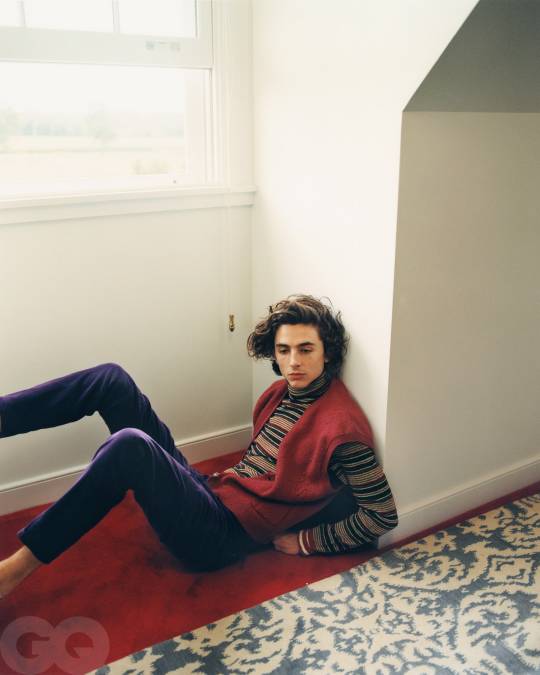
Timothée's career thus far has been filled with these sorts of friendships, notably those across generational lines. Even a casual observer may have picked up on it. Those glommings-on to older people in his life. Armie Hammer. Kid Cudi. Greta Gerwig. When I asked Gerwig to comment on the arc she's witnessed up close, from Lady Bird to Little Women, she wrote a note about “my friend Timmy”: “It's hard for me now, because I'm his friend, to see him strategically.… I love talking to him. We can get on the phone and talk for an hour or more without even realizing it, just skipping from subject to subject, making jokes, me feeling old and happy and him being funny and anxious and delightfully all over the place.” It's an odd gap he finds himself in—forced to be more accelerated than most 24-year-olds while also having not lived enough life yet to fit in absolutely with the people he enjoys spending time with most. On a recent visit with his grandmother in New York, she surprised him by saying, “I wish you would hang out with people your own age more often. It must be so weird.” It made him chuckle. Even she'd noticed. She might be right. But how could he resist the orbit of these creative geniuses he'd so long admired and who were filled with so much knowingness?
“I'm confident in the way I'm trying to approach things now, how I'm setting up the angles.”
In the winter of 2019, another Oscar campaign left him feeling disoriented all over again. Everything, Timothée said, was exactly the same as the first time except him. He'd put in this undeniable performance, but maybe one that sparked a little less for Oscar voters than that first kiss with a stranger. Now he was in all the same rooms as before, the same lunches and dinners and cocktail parties, shaking hands with the same Academy members who showed up at everything to get a little nibble of the freshest biscuit, growling ominous things at him, like: You don't have my vote yet.… “I really don't know how to talk about this stuff, man,” he told me, “because my experience of it is at the center of it. There's just some dark energy at these things, and this time around I felt like I could see it. And yet I'm thinking, Why isn't this going the exact same way?”
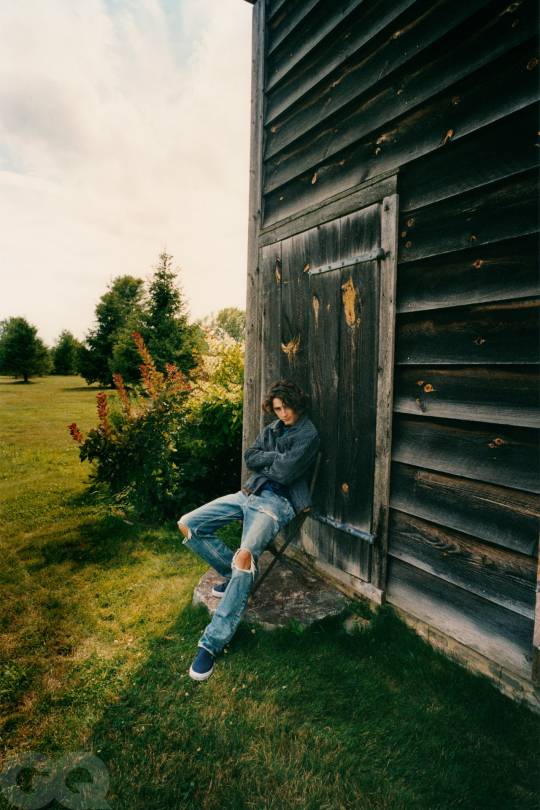
He wasn't nominated for Beautiful Boy, but the fresh air came, as it always seemed to, on the set of the next film: Wes Anderson's The French Dispatch. The movie is about a fictional English-language magazine (based on The New Yorker of the midcentury) and is structurally organized like the magazine itself, featuring short pieces at the “front” of the movie and a triptych of long features at the back. Timothée costars in the second feature, about a May '68-style student-protest leader named Zeffirelli and the middle-aged magazine journalist (Frances McDormand) assigned to report on his cause.
“I had seen Timmy in Lady Bird and Call Me by Your Name,” Anderson wrote to me, “and I never had the inconvenience of ever thinking of anybody else for this role even for a second. I knew he was exactly right, and plus: He speaks French and looks like he might actually have walked right out of an Éric Rohmer movie. Some time around 1985. A slow train from Paris, a backpack, a beach for 10 days in bad weather. He's not any kind of type—but the New Wave would have had a happy place for him.”

The privilege of early fame that Timothée most appreciates is the ability to choose the directors he works with. His role in The French Dispatch is a minor one, but it's a Wes Anderson movie—it's as simple as that. Due to the episodic nature of the film, some of the other “stories” were already being shot when Timothée arrived in Angoulême, a town that reminded him of the one he spent time in growing up, “so French it was like a caricature,” he said. Timothée had the opportunity, then, to hang with some of the elders he doesn't act with, like Jeffrey Wright, Bill Murray, and other seasoned members of the Wes Anderson troupe. “It was immediately as if it wasn't his first time with our group,” Anderson explained. “He was somehow already part of the family. The youngest member.”
Timothée had seen McDormand around for years, but he'd never felt like she was someone he could approach. “We'd shared an agent,” he said. “And it was no disrespect to me, but I hadn't been in any movies yet. What business do I have talking to Frances McDormand? But now, and this is the gift of acting, I really feel myself coming into my own as a community of thespians, as opposed to actors. And man, that sounds pretentious, but I just mean it's not about the fucked-up ladder of success and un-success, and being the guy or the girl, and then being off the list… That's not what I'm talking about with her on set, that's not what she's espousing to me. She's talking about a long career. She's talking about marriage with a creative partner and consultant. So to be able to have conversations like that and then a story line in the movie where they're kind of on an equal field? Even if she's an experienced, wise woman and he's an idealistic, naive boy? That's the exact relationship of exchange I want with my intergenerational peers.”

There's a particularly memorable scene in The French Dispatch, reporter and subject having fallen into bed together, when there's a knock at the door. Timothée looks at McDormand, anxious about who's there, mortified when McDormand informs him it's his mother. There, in that scene, we see all the desire of Zeffirelli—this energetic young man with all the right intentions, who strains to be intellectually and emotionally riper—clash with the reality of his age. It felt familiar to me, and no doubt to Timothée. It was some of my favorite acting in the film. I asked McDormand if there was anything in their scenes that struck her as particularly mature for someone his age. “Maturity is not something a fellow actor is the most concerned with,” she said. “Playfulness, discipline, and rigor. I do recall, during our scene in bed, the crew responding to his work with true respect for his focus. He was bringing it and we sat up and paid attention.” Anderson added: “I think my favorite moments with Timmy during a scene were the ones where I saw him pause and find a new attack. A new angle, which he does very clearly and assertively. What I love is how he will surprise you with something new, completely unexpected and perfect.”
One night, while McDormand was shooting a scene without Timothée, her husband, Joel Coen—he of the Brothers—asked Timothée if he wanted to go out for a steak. Over dinner, Timothée grilled Coen about Dylan. He knew Coen was a fan and had steeped in it on Inside Llewyn Davis. “He almost seemed weary of even talking about this stuff, it was so big and potent,” Timothée told me. But Coen noted that the truly incredible thing about Dylan was not so much the quality, which was obvious, but the quantity—the rapid amount of work in short succession, one groundbreaking album after another, in those early years. That takeaway resonated deeply with Timothée. Especially as he reflected on it from summer 2020, during the pause, during the moment of no work. That gush from Dylan made him want to work—harder, longer, better, more.

A week after our conversation in Woodstock, Timothée and I were in New York City, sitting on a bench along the Hudson, talking about what he's looking for when work resumes. “I want to get back to the undefined space again,” he said. “I'm chasing a feeling. When you think you're doing some great thing, it's probably something you've done before, and when you really fucking have no clue, that's when you're doing something on the edge, good or bad.”
Timothée's mask had slipped down his face as he was saying this, and two young women, about his age, approached cautiously. “Would you mind if we got a…,” they asked, and he hopped up without hesitation. “How'd you recognize me?” he said, friendly, but genuinely curious, as if he hadn't just been shouting about art in a voice that sounded a lot like Laurie from Little Women or Timmy from late-night shows.
“Was it the scrawny limbs or the hair?” I asked him as he sat back down.
“Definitely the first.”

From France, last spring, it was straight to Hungary—right back to the exact apartment in Budapest he'd stayed in while shooting The King—to start work on Dune. Very few actors had become as famous without a blockbuster. And while he'd really gotten it down how to act on an indie set, how to make every second and every take count, he knew this would be something altogether different. It wasn't just the shoot that would prove taxing. A film of Dune's scale would likely be the can opener to a whole other stratum of Hollywood prominence.
Director Denis Villeneuve told me Timothée was his “first and only choice” to play Paul Atreides, “the one name on the page.” When they met to discuss the prospect, Villeneuve told Timothée how happy he was to finally meet the young actor. And Timothée had to remind him that they'd met before, when Timothée read for Villeneuve's Prisoners. “ ‘Of course!’ ” Villeneuve remembered. “He did a great audition, but he didn't physically fit the part. He was probably swearing at me because I didn't take him.” Timothée was party to so many stories like that one—glancing interactions with these heroes of his before he'd broken through. It reminded me of the relationship between freshmen and seniors in high school. The freshmen remember everything about the seniors; the seniors hardly notice the freshmen. But we all become peers eventually.

“I felt there was one being on this planet right now that would be able to portray Paul Atreides,” Villeneuve said—referring to the hero of the 1965 Frank Herbert novel, who transforms from an unassuming heir into a messiah figure, a charismatic outsider and commander of men and women (and sandworms). I read Dune for the first time this summer and was shocked by the source material, how much I'd consumed in culture that had borrowed from it. Star Wars. Alien. The Matrix. Game of Thrones. Paul, therefore, is a type we're familiar with but also possessing singular characteristics Villeneuve wanted Timothée for: “He has a deep, deep intelligence in the eyes. Something you cannot fake. The kid is brilliant. Very intellectual, very strong. And you see that in the eyes. He also has a very old soul. You feel that he has already lived through several lives. And at the same time, he looks so young on camera. Sometimes he'd look almost 14 years old. He has this kind of general youth in his features and the contrast with the old-soul quality in his eyes—it's a kid that knows more about life than his age. Finally: He has that beautiful charisma, the charisma of a rock star. That Paul will lead the whole population of a planet later. Timothée has that kind of instant charisma onscreen that you can find only sometimes in the Old Hollywood stars from the '20s. There's something of a romantic beauty to him. A cross of aristocracy and being a bum at the same time. I mean, Timothée is Paul Atreides for me. It was a big relief that he agreed, because I had no plan b.”
“If I get hit by a truck next week, I'm looking at 20 to 23, I don't know if you can top that.”
I asked Villeneuve if he noticed Timothée struggling at all to adjust to the larger-scale production. “It didn't show when he was on set, but I think for him the big thing was to learn how to create his own bubble on set. So that he would not have to try to be the friend of everyone. When you're on a smaller set, when there's 25 people, you can be friendly with 25 people. When there's 800 people around, you cannot be friends with 800 people.” He chuckled. “It's too much. So how to save your energy, how to focus, how to give himself permission to be in his bubble and make sure that his bubble is respected.”

As ever, Timothée had a special affinity with those people on set who were a little older, a little wiser. Villeneuve said Timothée was constantly speaking with him and his wife in this open, vulnerable way about his concerns, his fears, how to deal with certain pressures. Villeneuve also described for me Timothée's relationships with his fellow actors, particularly the trio of Josh Brolin, Oscar Isaac, and Jason Momoa. “I felt like Timothée was deeply seduced—or maybe not seduced, but I just felt it was like a kid being with older brothers,” Villeneuve said. “He was younger, he was the little one on set, and everybody loved him. There's a scene in the movie where Timothée runs into the arms of Jason Momoa, and Jason grabs him like a puppy and lifts him into the air like he was a feather. And that's real! They really loved each other. It was very beautiful to see this young man being influenced by these people he admires.”
“His positive energy is infectious,” Zendaya, his nearest peer in the film, told me. “He really is so much fun to be around. We have very similar humor, and we can keep a joke going for a long time, but when the cameras start rolling and it's time to work, you can see it's game time, and he just taps into this brilliant intensity. It's awesome to witness.” Villeneuve underlined the energy as well, describing for me just having seen Timothée the night before we spoke, and marveling at “that beautiful, strong candor.”
“I will say that looking at Timothée working, I had a deep feeling that I was watching the birth of something,” Villeneuve added. “Not that it's for me—I say that with humility, because I feel that birth in all the movies he's done so far. I'm feeling it's someone that has insane potential. When I say potential, I don't want to reduce what he's doing right now, not at all. It's just that sometimes you are in front of somebody and you have the feeling you are in contact with a strong artist and that artist, his identity is still growing, building itself, learning its boundaries, learning how to protect some part of it. I think that we are witnessing something beautiful right now.”

At the end of summer 2019, Timothée finally resurfaced from Planet Dune. He had been on social media only sporadically while shooting for most of 2019, and so, for his vast base of fans, it was an overdue glimpse of the object of their affection. First up was the Venice Film Festival and the premiere of The King. There were clothes and Kid Cudi cameos and charming red-carpet interviews. It was an example of the sort of stretch, in the gaps between shoots, when Timothée could indulge his passions for hip-hop and fashion and all these things he'd loved all his life that were suddenly accessible. It was another of the delirious disorientations of the past few years—the way that people who were once subjects of his intense fandom were suddenly a part of his life as friends or acquaintances happy to have him around. He might still embarrass himself at times, helplessly rapping back lyrics to his hip-hop heroes or gushing like a broken dam about new music or clothes or art made by the makers in his life, but they were cool with him so long as he actually kept his cool.
Timothée also spent the end of last summer promoting The King, alongside his costar Lily-Rose Depp, whom he'd been dating for about a year. He is serious about keeping his former relationship with Depp to himself, but he did share one very sweet, very funny, very sad anecdote that encapsulates the spectrum of great and terrible that accompanies the private life of someone new to mega-fame like Timothée.

After Venice, he and Lily-Rose took a few days for themselves in Capri, where they were photographed by paparazzi. One image, in particular, circulated in which they were making out on the deck of a boat. Timothée is contorting himself into the kiss and looks a little awkward. Many people had their laughs. And some even suggested that the photo was staged for publicity. “I went to bed that night thinking that was one of the best days of my life,” Timothée told me. “I was on this boat all day with someone I really loved, and closing my eyes, I was like, indisputably, ‘That was great.’ And then waking up to all these pictures, and feeling embarrassed, and looking like a real nob? All pale? And then people are like: This is a P.R. stunt. A P.R. stunt?! Do you think I'd want to look like that in front of all of you?!”
This was how things worked now. He'd disappeared into those four straight films and emerged into a new paradigm—one that followed him into the holiday season of last year and a whole new level of exposure with Little Women. Here was this film about sisterhood, female intimacy, and a feminist critique of art and commerce. And yet Timothée was still the shiniest object in the set for so many fans. “I'm very used to answering questions about Timothée's hair from 15-year-old girls,” Saoirse Ronan joked with me. “I imagine that's probably what you're going to ask me about?”
Ronan has the unique perspective of having filmed and then promoted two movies with Chalamet during the past three years, and has as clear an eye as anyone onto this early phase of his career. “He's had such incredible opportunities, and he doesn't let the reality of that pass him by,” she said. “He's incredibly gracious and grateful in relation to his work and the people he works with. I think he's become more open as an actor. He knows his instrument more. I think he works even harder now because there are projects that are on his shoulders in a way that they weren't before. And of course he's been totally catapulted into this whole other realm of attention and notoriety. So he's also having to balance the incredible fame and attention, which would completely freak me out if it was something I had to go through.”
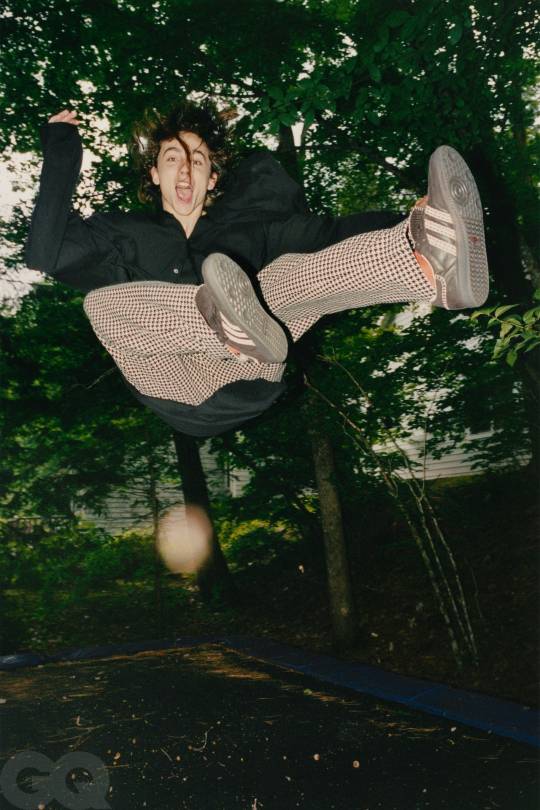
.
“I've realized that as much as these heroes of mine mean to me, and as grateful as I am when they offer me advice, even they acknowledge it's just a different thing now.”
When Timothée and I were sitting by the Hudson that afternoon back in summer, there were those two young women who approached him for a photo. But there were also two other young women who caught an eyeful of his profile as they strolled by and then surreptitiously positioned themselves out of his sight line but still in mine. They did that thing where one pretends to take a picture of the other while actually shooting back over her shoulder in selfie mode. That charade went on for five minutes or so while Timothée exercised his guts about reuniting with Gerwig and Ronan on Little Women, and though I was nodding along, I was also marveling at the lengths to which those two fans were willing to go to get a picture of him.
I asked Ronan what she's noticed about that level of attention, sitting beside him for so much of it. “I'm always kind of shocked by those things—when any one person can just completely take over people's lives so much,” she said, laughing a little incredulously. “But I'm also not surprised. There just aren't many other young male actors out there like him, who are able to hold an audience in the way that he does. His look is so magnetic and beautiful. One of the things that we spoke about a lot when we were doing Little Women, in terms of our characters, but also in terms of myself and him as people, is that we both have this masculinity and femininity equally. And I think that that's one of his strengths, is that he can be incredibly sort of feminine and sensitive and sensual, and also he's a guy that, you know, girls fancy. So he covers so much ground in terms of popularity. But at the end of the day, he's always gonna have this skill. He can be cute, but that only gets you so far.… And so I've seen him learn how to separate himself from all that other stuff when he's on set, when he's working.”
In Woodstock, Timothée had described to me with greatest admiration the way that Ronan can act in these films, at this highest level of acclaim and attention, but also remove herself, uncomplicatedly, from all the fuss: “She is like a superhero when it comes to this sort of thing, going through it so healthy—with the asterisk being excellent work across the board and four Oscar nominations. I think her, like, DNA of self is really morally right.” She knows herself extremely well, he said, and has the confidence to give up only so much of herself. Whereas he feels he is calibrating constantly how much of his true self to reveal. “Saoirse's one of my best friends in the world—at least I think we're best friends. And she's never judged me for…the Coachella of it all.” That is, the part of him that can't resist fanning out backstage with his favorite musicians or occasionally allowing himself to be in the spotlight even as he talks about preserving his privacy.
“He's 24, and he's gonna have a great time, and I would never judge him. I've been to Coachella; I just never got photographed at Coachella,” Ronan said, chuckling. “But yeah, we talk about that sort of stuff all the time. We've weirdly gone through this together for the last few years. We've both become more accessible. But he's had one sort of attention—I do feel like boys get it on a whole other level. I know that ultimately what he wants is to be good at his job. And that will always steer him on the right path. I've always let him know, and he's always let me know, we can talk to each other, and we do. He has good people around him, and I'm one of them, and Greta as well—we all kind of look out for one another.”

Timothée spent late May and early June asking questions of himself: What can I do? What is my role in all this? He felt conflicted when he sprang to action and conflicted when he stood still. But never did things feel less uncertain, less self-conscious, than when he was marching, anonymously, alongside hundreds or thousands of others in Los Angeles in the wake of the murder of George Floyd. It was an active way to participate—meaningful action, without being showy, without flexing any of the levers of fame or power. He was going to get hit no matter what he did, so he tried to follow his instincts of what felt humble, responsible, right.
“This idea,” he said, “that power is the mass body politic organized—and how many bodies can you get together—that makes sense to me.” He didn't disappear but, rather, stripped himself of his him-ness and became one body, among many, taking up space and participating in an unequivocal statement. “With a mask, a hood, a hat, glasses—my face is deleted,” he explained, “and I'm literally presenting a physical form, you know?” A single body in space that, like a vote cast in an election, is democracy embodied, but anonymous. The same unit of power as anyone else. “People might find it disingenuous, but I found it really grounding,” he said. “It was Oh shit, I don't feel out of place—and yet I haven't been in a crowd like this for years.”
He spent much of the summer talking with others about how a person should be in a cultural and political moment such as this one. “After a day of protests,” he said, “I'd ask friends if they ‘felt good.’ If we do, is it a good thing to feel good, or does that mean we're doing it for the wrong reasons? How much do I want to put on social media? Is it a virtue signal to put it on social media? But all social media is performative, right?” I heard him ask dozens of self-interrogating questions like these. He cares so genuinely about doing the right thing, about doing well by his family, his friends, and his fans. But he didn't want to misuse his privilege or his platform, to overreach so that the gravity of his fame sucked up anything from anyone else whose moment it was to speak. He didn't want to take up room; he wanted to help center other voices. On Instagram, he posted videos each day during the first week of marches in Los Angeles—no directives into camera, just an implicit charge to his followers: Show up. Listen. Be a body.

“I have so many thoughts on so much of it,” he said, “but I don't see the benefit of putting it down for consumption until I've really worked out exactly how I feel about it all. Who benefits from my half-baked ideas?” Who cannot relate to this in 2020? Who would want any of their dinnertime conversations with family and friends these past months chiseled into the stone of the internet? “I care so much about this stuff. But I would never want my caring to be misconstrued. I don't want my caring to be about me in any way.”
God, this stuff twisted him up. He knows how much has gone his way. But from the summit of good fortune and power, is it better to speak constantly—or to shut up, put on the glasses, pull down the hood, and live and act according to one's convictions as one individual among many individuals? To march. To vote. To speak through action rather than words. Staying in motion, showing up, being a body—it's a good place to start while he works out the rest of how he's meant to live a life true to his values with everyone watching.
He's seeking out the right path, the right people—with help from his “intergenerational peers” and Dylan and anyone else he can find. He wants the benefit of their knowledge and experience, and he's okay if it's slow going to accrue it. He's open to playing the role of the novice still. But there have also been things in his life these past of couple years that have made him realize, as he puts it, “adults are just kids a little bit older.” When he returned to New York from Los Angeles this summer, it wasn't to his childhood apartment or to a borrowed living space of an acquaintance. It was to his very own apartment, his first, in a little wedge of Manhattan he loved for being nowhere, but on the edge of several somewheres. He relished the mundanity of setting up his own place. To hear him talk about a first trip to CB2 was like hearing another person talk about their first trip to a movie set. “But I think if people saw what my apartment looked like, they'd be like, ‘Oh! This kid has no fucking clue what he's doing.’ ” He is so young and he is so old. It is his gift. He is so patient when he can suppress being so restless. So careful with the long arc of a career when he can resist obsessing over the instant. He is so confident when he centers on the work and so searching when he gets sucked down into questions about the rest of his life. Will he always be this way? This pliable and open? This self-reflective and intentional? He trusted so little of his new life, but he trusted his talent. That was the key. He knew he was as good as anyone at playing other people, even if he was still figuring out how to play himself.

We spent a good amount of time in Woodstock and in New York City and on the phone talking about where his career might take him from here. With great humility, he acknowledges his skill. But he has been thinking a lot about the difference between preternatural talent and mastery—the work that's required to ascend from that floor of young greatness to the ceiling of realized potential. That said, he's wise enough to know that his career could pivot in an entirely different direction—that the world could change or the opportunities could dry up or “eventually there's gonna be an Oscar Isaac in his 30s who's gonna bust out of Juilliard who's gonna be the next great actor and make me feel like a piece of shit. But right now…”
He told me, “If I get hit by a truck next week, I'm looking at 20 to 23, I don't know if you can top that.” To show up with Call Me by Your Name—he knows that that film was a unicorn, the sort an actor works his whole life to find. And the immediate Oscar nomination had freed him up to not spend the rest of his career chasing a certain kind of role that might lead to a certain kind of validation. “I'm not gonna be bashing my head against a wall trying to prove that I'm an actor,” he said. “The train can run over my leg and leave a track forever, and yet the point of entry for me…,” he said, trailing. “That's a good feeling.”
He looks at all these careers—all the careers you might expect: DiCaprio, Bale, Phoenix, Depp. And he does his best to separate the strands of each of their careers that might still apply to his. But all of the rules for acting success that those performers played by, for how to be in the public eye, for career arcs and longevity—those rules are irrelevant now. Hollywood is different, the media is different, fans are different, movies are different, the world is different. “I've realized that as much as these heroes of mine mean to me, and as grateful as I am when they offer me advice, even they acknowledge it's just a different thing now.”
And so it's occurring to him that the next few years will be Timothée finding the path that's right for him. Lately, he's thought about this next phase as shining a flashlight into the dark. There are potential projects that excite him considerably, some of which he's had a greater hand in engineering. There is, of course, the Dylan movie. But there's the question of how to spend the rest of the year, when most Hollywood productions are still paused. “The rest of the year,” he says, “I'm just thinking about Trump, man.” But after that…maybe Europe for a while? The Woodstock experiment did what he'd hoped it would—a little space, somewhere else. He would love to just breathe some different air again.
He was at another pivot point, as he had been when he and I were first together for Chapter 1. In the winter of 2018, the work had been validated, the public profile had developed suddenly. But the temptations, the confusion, the money—those were all lagging indicators. By mid-2020, all had caught up. And the money, in particular, was on his mind one afternoon in New York. We were talking about how a person might stay true to one's roots with that sort of thing when the reality, for him at least, had changed with Dune. I told him that one of the things that seemed to differentiate him from young stars of the past, and perhaps was a feature of his generation, was the way that material possessions didn't consume him. He didn't buy much stuff. He didn't own a car or a house. He liked borrowing clothes, but not necessarily keeping them. He agreed with the characterization, but then got immediately twisted up about a potential future hypocrisy: “But Dan, what if I do grow to like fancy shit?!”
Boomeranging back home after the surreal adventures out in the world—that was a good and grounding thing for him. Over the weeks we were talking, he spent time with his folks, delivered some COVID groceries to his grandma, and was in touch with his sister daily. And in New York, he and I kept running into ghosts. One afternoon, when we crossed the West Side Highway at Houston Street, he gestured at the athletic complex at Pier 40, where he played soccer growing up. He scampered over to a vending machine there to grab a bottle of water. When he pulled open his wallet to pay, he had only twenties. “Bad metaphor! Bad metaphor!” he screamed, jumping away from the vending machine, as though it were one of the great threats to his selfhood. This was the sort of innocuous moment that will hum with outsize resonance for me when I think about Chapter 2 from the future. All the things that one would expect to happen had happened in the first two and a half years since the arrival of a comet, and yet he was suspicious of so much of it.
Here is another way I will remember him from this moment: sitting on that porch in Woodstock—breeze and birds in the trees, sunlight in the leaves—looking for a higher power. Or at least expressing openness, as a nonreligious person, to the idea of some central organizing force in the universe—because, given everything lately, there has to be or we're fucked, right? Some of these searching things he said to me could be mistaken as a person spinning out a little. But that wasn't it at all. There was such calm. There was such contentment with the grace that had been afforded his life and career thus far, and where each might take him next. He was questing, yes—but he was firmly at the controls. The flashlight in the dark. Someone moving forward with great confidence into the unknown, with eyes wide, mouth shut, and ears listening more than they ever had before. There were no models for how a person like him should be anymore. There were no longer any adults who weren't just kids a little bit older. There were no blueprints for how to shape a career—so much had changed. There was only a head and a heart, his, and a feeling for the moment. “Maybe I'll never do a great work of art again, but I just feel like I'm confident in the way I'm trying to approach things now, how I'm setting up the angles,” he said on that porch in Woodstock. “When you think about Dylan. When you think about what Joel Coen said about the rapidness of the art, I'm just like: Trust the beat of your own drum. Give this its best shot. Give your artistry its best shot.”
.
Daniel Riley is a GQ correspondent and the author of ‘Barcelona Days,’ which was published this past summer.
A version of this story originally appears in the November 2020 issue with the title "Wild Heart."
PRODUCTION CREDITS:
Photographs by Renell Medrano
Styled by Mobolaji Dawodu
Tailoring by Ksenia Golub
Produced by Wei-Li Wang at Hudson Hill Production
437 notes
·
View notes
Video
youtube
Kraftwerk are best known for being innovative pioneers in the field of electronic music, but by 1981, the rest of the world was finally catching up to them. Faced with living in the future they’d helped create, they released their last truly great album, Computer World, as a sort of reaction to the times. Find out more in my video, or by reading the transcript below the break.
Welcome to Passionate Reply, and welcome to Great Albums. Today, we’re talking about Kraftwerk, and what is perhaps their last truly “great” release: 1981’s Computer World.
Kraftwerk were, of course, one of the first groups to popularize the creation of music through chiefly electronic means. From their icy and robotic onstage demeanour to their stiff-shirted sense of style, just one look at them makes it clear the outsized influence that Kraftwerk have had on the genre we now think of as “electronic music.” While, at times, their significance can be over-emphasized, and I’ve always been critical of the way that the discourse on this all-male quartet has often squeezed out even earlier electronic pioneers like Wendy Carlos and Delia Derbyshire, it isn’t all for no reason. While Kraftwerk’s actual music often comes across as more accessible than experimental, the fact that they were doing it in the 1970s, long before synthesisers became a commonplace sight in popular music, should fill anyone with the sense that they were architects of the future.
Music: “The Model”
While “The Model” first debuted on Kraftwerk’s 1978 LP The Man-Machine, it was re-released as a single in 1981, where it saw substantial success in the charts. In those few short years, the musical landscape had changed, with younger artists like Gary Numan and OMD making headway in the charts with similarly synthesiser-centered songwriting. For almost the entirety of the 1970s, Kraftwerk had been contentedly putting along, secure in the knowledge that they represented the future of music. But now, as the 80s began, they were finally living in the world that they had made possible. The future had arrived for them--so what were they possibly going to do now? I think the best way to frame Computer World, and perhaps what makes it such an interesting album for me, is that it represents a reaction to the ways that the landscape of electronic music had shifted around the artists in these intervening years. On Computer World, Kraftwerk would both reflect as well as critique what younger artists inspired by them had started doing. It’s the first Kraftwerk album that seems to represent a true challenge being posed to these by now august and illustrious pioneers, forcing them to respond in new ways.
Music: “Pocket Calculator”
In many ways, “The Model” is a pop song--compared to most previous Kraftwerk compositions, it’s heavy on lyrics, and focused, surprisingly, on a human being, and a love story involving her. But I think the Computer World single “Pocket Calculator” is almost as good of a pop song as “The Model” is. Highly melodic, and almost candy-coated in its simpering exuberance, it has perhaps the hookiest hook anywhere in the Kraftwerk discography. I’m tempted to compare it to similarly bright and upbeat tracks from Yellow Magic Orchestra, such as “Ongaku”--particularly since it was also released in a Japanese-language version, as “Dentaku,” for that market. Still, there’s no avoiding that the subject matter of “Pocket Calculator” has taken a sharp turn back towards an iconically Kraftwerk subject matter: the inner life of the titular machine. While the narrator of the lyrics announces themself as “the operator” with the titular calculator, it’s also possible to interpret the lyrics as the voice of the machine itself. “I am adding and subtracting, I’m controlling and composing”--but who, indeed, is really performing these tasks: the operator, or the calculator itself? Perhaps a stronger example of Kraftwerk gone pop is “Computer Love.”
Music: “Computer Love”
Melodic, but also balladlike, “Computer Love” is an unambiguous return to the traditional pop theme of romantic love, absent from the asexual and perhaps childlike glee of “Pocket Calculator.” Its more plaintive hook is also an easy one to appreciate, and its theme is perhaps more universal: while listeners at the time may not have necessarily owned rapidly miniaturizing digital technology, surely, all of us have, at some point, felt lonely. “Computer Love” doesn’t just connect to that feeling, but it also offers us hope, in the form of an almost magical, futuristic solution for finding love. I think it’s the internal balance of “Computer Love” that makes me find it so captivating: it’s a song about despair at being alone, perhaps even intensified by the alienation of modern society in particular, but it’s also suffused with the romantic dream of computerized matchmaking services, which might, like so many other technological developments, tremendously improve one’s day-to-day life. In “Computer Love,” the machine is only a tool, a small piece of the overall human picture, and not the chief focus of the work--much as the camera for which “The Model” was posing was little more than a prop in that love story. But despite this optimism about online matchmaking, other tracks on the album seem more skeptical about our computerized future, including the opener and title track.
Music: “Computer World”
While Kraftwerk are best remembered as utopian thinkers, many of their compositions hint at the potential downsides to technological advancements, albeit subtly. Much like *The Man-Machine* alluded to works like Fritz Lang’s Metropolis and Karel Čapek’s R.U.R., the title track of *Computer World* prominently notes organizations like Interpol and Scotland Yard among those who may benefit from computers, hinting at fears of oppressive techno-surveillance expressed by works like Philip K. Dick’s “The Minority Report.” With its slinking rhythm and overall ominous feel, this track implies that we should be apprehensive, without necessarily stating what to fear, and I think that’s part of why it’s remained resonant. In today’s world of deepfakes and location tracking, we’re constantly vigilant over the nameless potential dangers presented by the machines in our pockets and handbags, even when we couldn’t explicitly state what they are. Our increasing distance from the album, in both time and technological progress, may present an obstacle to appreciating it as art. While it’s easy for me to get into the mindset of computers as something newfangled and exciting, having grown up earlier in the personal computer age and able to recall the way they were advertised and talked about in the 90s and 00s, I do wonder how this album sounds to my younger peers. At any rate, “Numbers” is the track that I think sounds the most like it could have been on any Kraftwerk album, and not just this one.
Music: “Numbers”
A classic example of how a simple conceit can fill a whole composition to its brim, “Numbers” remains one of Kraftwerk’s most iconic tracks. Nowadays, it might be best known for how heavily it’s been sampled by later artists, and the influence it’s had on hip-hop, that nephew of electronic music that is nowadays, somewhat arbitrarily, considered a separate genre unto itself. But ultimately, “Numbers” and its famous beat stand up perfectly well on their own. As a cosmopolitan panoply of languages recites the names of the numbers, we are reminded of the ways in which mathematics is a universal language. Not only does it unite mankind, but many have also wondered if it might someday be the key to communicating with people from beyond the stars--an honour also bestowed upon music itself. Structurally, “Numbers” is the second-to-last song on the album’s first side, and like many earlier Kraftwerk albums, it transitions directly into another part of a larger “suite,” connected both musically and thematically. “Numbers” becomes “Computer World 2,” which is not simply a reprise of the title track, but a sort of medley which also incorporates the whispering vocoders of “Numbers.” While in many ways, Computer World feels like an attempt by Kraftwerk to keep up with the times, the overall structure of the album maintains a sense of continuous, symphonic composition, not unlike the seamless “transfer” between “Trans-Europe Express” and “Metal on Metal” some years before.
The cover design of Computer World is another in the long list of the aesthetic triumphs of Kraftwerk, which, I maintain, are perhaps as important and influential as their music itself. Its bright yellows and greens remain eye-catching, as does its portrayal of the band members’ portraits, rendered on a computer terminal. Despite seemingly now only existing in cyberspace, their faces remain in the position we saw them in on The Man-Machine, projecting their beatific gazes towards the leftward horizon of the future. The struggle between the reality of a human being, and that which is affected by their simulacrum, is a strong theme throughout Kraftwerk’s discography, stretching back, at least, to “Showroom Dummies,” and the cover of Computer World seems to take it another step further. Now, we don’t even contend with the idea of physical replicas of humanity, in the form of trudging robots or glib mannequins, but rather with the idea of an ethereal, holographic doppelgaenger. With its title, the album asks us not only to consider computers as technologies in and of themselves, but about an entire new era, and a new way of being, which is brought about by their arrival and proliferation. In many ways, this way of thinking about the future was more correct than perhaps anyone knew at the time, and I think it’s this sense of vision that makes Computer World remain a vital artwork as opposed to a curiosity.
As I said in the beginning, Computer World is often considered to be the last great album Kraftwerk made, putting an end to their streak of classics that began with 1974’s Autobahn. Their follow-up to it was the troubled and controversial Electric Cafe, released in 1986, which attempted, unsuccessfully, to add more dance influences and samples with the textures of more traditional instruments into their sound. While I think Electric Cafe is an album not without its merits, it is certainly a substantial departure from the Kraftwerk sound we’ve gotten familiar with so far. I might characterize it as an album that perhaps went too far into the territory of attempting to keep up with the times, extending Computer World’s lunge for more accessible, lyrical pop further than it could reach. Whatever the motivations, it’s hard to hear Electric Cafe tracks such as “Sex Object” without being at least a bit startled at the group’s willingness to tackle the topic of sex so frankly. It might be the only Kraftwerk song in which being like an object or a machine is portrayed in an unambiguously negative light.
Music: “Sex Object”
I think my favourite track on Computer World is its closing track, “It’s More Fun To Compute.” With a straightforward repetition of the title as its sole lyrical content, and a brazen, strident synth blast propelling it forward, it’s another one of those simple, but utterly compelling tracks that Kraftwerk seem to have been full of. Despite the way it flips into something much more melodic later on, it’s the tumult of the opening bars that really sells me on “It’s More Fun To Compute.” I think the textural qualities are almost a bit reminiscent of the grating oscillations of their often overlooked earlier album, Radio-Activity. That’s everything for today, thanks for listening!
Music: “It’s More Fun To Compute”
22 notes
·
View notes
Text
Stuff I read (and liked) this year
As promised, here’s a list of the novels, comics, manga, etc... I read this year, focusing on the ones I enjoyed and would recommend to people. Under a cut, this is going to be a little long.
-------- Books --------
Favorite book of the year: Stranger in the Woods, by Michael Finkel
Non-fiction. Based on the interviews of the man himself by the author, it is about a man who felt so unfit for society he decided one day to leave it, and spent the next 28 years as a hidden hermit in forest in Maine. The book details how he survived there, how he was eventually found, and some of his reasons for doing so. It’s a great reflection on the nature of loneliness.
Indian creek, by Pete Fromm
...Yet another detailed tale of living alone in the woods. This time, the diary of a student who spent a winter in the mountains to help tend for salmon hatchlings, and how he spent the rest of his days hiking, hunting, meeting the locals. It’s a fun little book who, being set almost the whole world away from where I live, was a nice way to travel.
Howl’s Moving Castle, by Diana Wynne Jones
I don’t feel the need to explain this one since everyone and their mom has seen the movie adapted from it. The book, that I first read a decade ago before I actually watched the film, is a less romantized, more spirited telling of the same story. The writing is absolutely delightful and so is the world it paints, and it’s the first time in ages a book had me laughing out loud during my entire read.
-------- Comics (BD) --------
Favorite comic of the year: Monsieur Désire?, by Hubert and Virginie Augustin
A discreet young woman becomes a maid for a decadent, unbearable, byronesque young lord. Caked in the rigid and oppressive social hierarchy of the victorian era, you follow a mental and verbal joust between the two, as the lord tries his best to offend and corrupt his new unrelenting servant, to little success. The writing and especially the dialogues were stellar, drawing me into the tense atmosphere, watching this trainwreck of a character flamboyantly destroy himself. While there’s no precise content warnings that I can give, this is a mature and heavy story.
World of Edena, by Moebius
Anyone who’s followed this blog for over a month knows how much of a Moebius fan I am. Edena combines the vague, dreamlike, wordless storytelling from stuff like Arzach or The cat’s eyes with an actual plot. While I haven’t completly finished the story, the evolution of the main characters and how the story is told have been great to read through, and as always the art is beyond gorgeous. Unfortunately suffers from some good old sexism in the writing that even if minimal, tasted sour
Le roman de Renart, by Joan Sfar (book 1)
Sfar’s work always has a signature vibe of being dreamy and light without being light hearted, of being down to earth but drifting in the fantastical, and this one is no exception. It’s an adaption of a series of medieval folk tales I grew up with, who uses the same characters to tell an original story. If you’re familiar with icons like Renart as well as other mythological big boys like Merlin you’ll fit right in. There is something special in how the dialogues are written, who feel natural in a way that you’d overhear in a street corner and is very special to me.
The mercenary, by VIncente Segrelles
Another one I post about a lot on this blog. The mercenary is a king on the throne of fantasy cheese. The worldbuilding is interesting at times but the writing is a pretty pathetic display of glorious old time sword and sorcery sci-fantasy 10 years too late for it’s prime (warning for ye old sexism and orientalism that plagues the genre, cranked very high...) but you come and stay for the art. The entire thing is drawn in a series of hyper detailed oil paintings with an insane eye for technical detail, from the engineering of the weaponry, to the architecture and weather, to the anatomy of the fantasy creatures... Each panel stands out as it’s own painting which makes even flipping through it without reading the scenario a treat. Click here to see more of the art, in my Segrelles tag.
The ice maurauder, by Jacques Tardi
A short story about mad scientists entirely drawn like a 19th century engraving. In great Tardi tradition everyone is ugly and mean, it ends terribly, it’s both a hommage to the genre of late 19th cent. to early 1900s dramatic adventure novels and a critical eye on it, and it’s morbidly funny. Most people I saw online hated the way this was written but I’m not them and I really recommend this book. Die mad
-------- Manga --------
Favorite manga of the year: it’s a tie between the following two.
Cats of the Louvre, by Taiyo Matsumoto
Most wonderful comic I have read in ages. The story follows a bunch of semi-feral cats secretly living in the Louvre museum’s attic, and the small group of humans who share their life, walking through the museum as the night watch. When the cats are together, they are represented in a humanoid way, but still act like animals, and “become” cats again when a human is nearby. The plot is a sort of supernatural mystery centered around a kitten who walks around paintings. It’s a love letter to art, sincere and beautiful, with a unique art style and great characters.
Memoirs of amorous Gentlemen, by Moyoco Anno
A sex worker in early 20th century paris starts writing down a diary of the clients she meets, in a quest to cope with the troubles of her life. You follow her, her colleagues, and her bittersweet relationship with an abusive lover. I don’t have much words about this comic, but the art and writing both are amazing, it’s the perfect length and drew me in like little series had before. Obvious content warnings as this is an adult story that talks about sexuality, but also depicts both mental and physical abuse.
Hana, also by Taiyo Matsumoto
A very short story, this was not made to be read as a comic originally, but served as storyboarding and visual development for a play, and the way it is written follows that. Hana is a slice of life story set in a fantasy world, of a young boy, his family, his village. Despite the setting being an original one, the character interactions are refreshingly... normal, and there is no huge plot to speak of, just a bit of the life of these characters. The art is beautiful, entirely black and white, with a scratchy style and an emphasis on contrast. Matsumoto is on a speedy road to becoming my favorite manga artist haha
Delicious in Dungeon, by Ryoko Kui
While not marked as my year’s favorite, I still consider this series among my favorite manga ever. The art and writing are amazing, and it’s both heartfelt, well concieved and plain hilarious. The story follows several parties of dungeon diving adventurers each on their little quests with a premise of our protagonists, on a panic rescue mission, surviving in the dungeon by cooking and eating the monsters they come across. From a DnD party turned cooking manual dinner of the week beginning, the plot creeps up on you and slowly thickens. I don’t want to spoil anything about the overarching story of this because it was a delight to discover for myself. While everything about DinD rules, I am especially fond of the design philosophy of the author, who puts great detail in the practicality and biology of what she draws, as well as the character writing. Everyone even side characters has so much charm and depth to them, the cast is so diverse and entertaining...! Each character is just a bit lame enough but endearing, and has their own little backstory that shows in the way they exist. It’s a delight
Chainsaw man, by Tatsuki Fujimoto
I went into CSM expecting a borderline campy hyperviolent dumb fun thing to read and was very surprised to find an uncomfortably well written story about a teenager being groomed. The hyperviolent dumb fun fights are here nonetheless and the series still qualifies as shonen for some reason, but the more mature character writing as well as some truly outlandish visuals make it something very special. If you can’t stand shonen, not sure you will like it, but if you don’t mind it, worth trying.
Witch hat atelier, by Kamome Shirahama
The oh so elegant fantasy seinen every cool kid started posting about this year, who I also succumbed to and fast. Witch hat is hard to explain, as most of it’s plot revolves around the rules of the world it’s set in, specifically the regulations around it’s magic and the social and historical reasons for them. It’s about growing up, learning, disability, making art. You follow a little girl taken in by a witch as an apprentice, her magical education, and learn little by little why her lovely teacher is so willing to break a lot of rules... While a bit too gentle and pretty for my taste at times, Witch hat has great worldbuilding and explores sensitive themes I rarely see in manga, much less in fantasy. And Berserk wishes it had art this good
24 notes
·
View notes
Text
NCT 2018 Empathy Era
Visuals:


pitch black hair, pretty long and always wavy or curly
honestly people go feral over hannah with dark hair
her styling was perfect for every concept
the only time she wore pants though was during some boss stages
then skirts and shorts for everything else
baby don’t stop hannah is the styling everyone loves and is waiting for a comeback of
throughout the era, the visible loss of her baby fat in her cheeks could be seen if you compare her from like we young era to now
Album Credits: none
Line Distribution
MV:
Boss
a dance centric mv so there isn’t too much to say
her solo lipsyncing cuts were mostly on a roof and occasionally behind a desk in what looked like a ceo’s office
when taeyong and mark charged at each other, there’s a clip of her walking out of the room with a smirk like she planned that
for her rap with mark they were in the snow for a bit and in a museum like building
Baby Don’t Stop
another dance centric mv
but it’s only dance nothing else sooo yeah
Go
this is arguably hannah’s best mv
dance cuts stay the same
there are cuts of her walking around the streets of la with a smug smile on her face
there’s also a clip of her rolling her eyes then placing a lollipop in her mouth
in jaemin’s rap, she was against the wall, arms crossed while jaemin was in front of her kinda rapping to her
then it’s just flashes of her vibing with haechan, running, lying down by the edge of the roof, and doing graffiti
Touch
the literal first clip of the mv is just her looking up with the cutest smile on her face then high fiving mark while they did the intro
her solo lipsync scenes were in a pastel purple room with a pastel blue bed that she perched herself on
her and mark in the fuzzy room for their part ✊🏻
haechan kissed her cheek while yuta kissed taeyong’s
she honestly just looked like she was having the time of her life
Black on Black
same case as baby don’t stop
but let’s just note her back and forth rap with mark (a beginning trend in nct songs) and just seventeen men falling to the ground while she stood there
Iconic Moments:
her in that room during the yearbook where her name was written in holo letters
just the welcome nct 2018 vlive as a whole
aka the origin of the other neos beginning to call her princess after hearing jaehyun do so
“kun baba!”
not specific, but the way she would finally act like a kid around jaemin or some of the older members
the 00 line live as a whole aksjdsjdh
hannah somehow visiting chenle in shanghai for a day when he went back (and dancing with the elderly )
the moment her boss teaser with jungwoo was released people were going feral
“i became the boss for you”
no one knew that lucas and hannah were the multilingual mess of a duo that everyone needed
her comforting jungwoo when she saw him crying after his debut stage
hannah in the bds mv
literally no one was ready for hannah who was going “so what we hot we young” just a few months prior to suddenly performing bds
her thot popped out ✊🏻🤧
almost no one caught it but renjun called her pretty when they reacted to the bds mv
long story short no one was ready for nct u hannah
her go mv teaser with jeno and jaemin
nominah simps found dead in a ditch
the behind the scenes of the go mv when jaemin actually kabedons her and leans his face close to herswhile rapping
“oh my god guys compromise nct dream is the love”
the empathy showcase where she everyone was just getting whiplash at her multiple stage personas
when the jump to touch video was dropped and she WAS THERE
127 HANNAH?!?!
“i guess i’m a maknae now? i’m hannah”
her and mark’s high five in the start of touch’s choreo before he steps back, assisting her forward so she’s center of the beginning
an animalistic hannah in black on black 😳
her and mark standing there while the others fell to the ground in the choreo
“my brain hurts whenever doyoung oppa explains the concept of nct”
her dying in the boss team live
“they gave me water instead of apple juice”
“mark did you just calk czennies grass?”
empathy hannah was just another breed
#hannah.nct2018#nct 24th member#nct dream 8th member#nct female member#nct female addition#hannah#lee hannah
24 notes
·
View notes
Text
Build Your Own Sims 4 EP Challenge
Uptown World Expansion Pack
*My entry for #BuildYourOwnEPChall by #SimsBogdy99
The 3 models I made are wearing all black salon uniforms. Dressing in all black takes the focus off of the stylists and puts it onto the clients where it should be. All of their other outfits are made with their favorite colors in mind and are heavily themed with a 1980's vibe because I'm kind of stuck in that era because the music, fashion, and hair were so cool... still cool.
So on with the pack...
Welcome to Rockin Key, the home of some of the world's greatest musicians! Rockin Key is where the rich & famous go to play, and the locals that keep it going play here too. Located 5 miles West of Del Sol Valley, it's easy to find... follow the endless sounds of great live music across the 5 mile bridge to Rockin Key... the city that never sleeps. Rockin Key entertainment venues are open 24/7.
On Rockin Key you'll find many new venues & plenty of room to build with 15 new lots to build homes/businesses! Including new lot types such as hair salons, Day Care Centers, houseboats, indoor concert halls, and movie theaters.
Rockin Key (new) Venues Include:
-Santiago's Hair Salon - Sims can now visit Hair Stylists, Nail Techs, & Estheticians for a variety of services. Don & Jori and their team are here to help you be the best looking version of yourself. Remember, it's all about the hair!
-Rockin Key's Slice of Paradise Concert Theater - This is the largest new venue. This is where the biggest names in the sim music industry come to perform. It's always the hottest ticket in town.
-Rhapsody Twin Movie Theatre - Sims can now take their family, or a date, to the movies! The Plaza Twin Theatre has a full service concession stand, and the movie popcorn machine is always popping to make sure the popcorn is hot & fresh. To wash the popcorn down they also serve fountain sodas, and there's a variety of candy to choose from. In each theater for all sims' comfort, they'll find recliner chairs with built in soda & popcorn holders. It's stadium seating so no worries about someone's head being in a sim's line of view while enjoying their movie. And for the kiddies there are booster seats available.
-Sunny Sushi Bar - Indoor & outdoor dining w/ live music nightly by Toffee Butler (piano) or The Dunk-a-noos (steel drum band), located next to the marina.
-Moody's Marina - Here sims can buy/own a luxury yacht w/ hot tub & full bar. Yachts can leave port and travel the area. Sims can fish off of a yacht or they can now charter a fishing boat.
-Lil' Sponges Daycare Academy - Sims can now drop off their children at this Nautical themed, state of the art Daycare Academy for ages infant - 5 years old. This isn't just a babysitting service; as an Academy it has licensed teachers to teach age appropriate lessons while keeping track of each child's growth and progress in their speech, fine motor skills, gross motor skills and social skills. By the time these little sponges are ready to move on to Kindergarten at 5 yrs old, many will be able to skip right into 1st grade.
NEW CAREERS
-Hair Stylist
This career is for the sim that believes it's all about the hair. Once a customer has the right hairstyle, anything is possible! Hair Stylists can wash hair, cut hair, color/highlight hair, perm or straighten hair & blow dry hair. Top level Supreme Hair Stylists unlocks hair extensions that come in long, medium, short, & extra short (to add bangs/fringe to most hair styles already in the game) with each length also being in straight, wavy, curly, or braided styles, each available in all colors for both females and males, age teen-elder. Depending on the hairstylist's level will be the outcome of the hairstyle given, so sometimes with lower levels there may be mistakes and corrections needed that result in comedic reactions by sims/hairstylists.
*Supreme Hair Stylist Bonus: Becoming a CELEBRITY HAIR STYLIST: Once a sim reaches top level as a Supreme Hair Stylist, they will begin to gain notoriety and in time will reach "celebrity" hairstylist status. Once this is achieved they will start to receive celebrities/rockstars as clients, be asked to go on location to music video sets, and backstage at concerts, to work on musicians'/celebs' hair, and they'll hob-nob with the rich and famous. Also, a celebrity hair stylist can be Owner & Creative Director of a very successful hair salon w/ barely any problems. They'll even be given the opportunity to own a chain of hair salons if the first one is successful.
-Nail Technician/Artist
A career for sims that believe a person can't be their very best without well manicured hands and feet. Services provided, how well and how quickly done, depends on the level of Nail Tech/Artist. Lower levels may either take longer or make mistakes such as wrong nail color or spills water on the client. Once a higher level is reached the Nail Tech adds Artist to their repertoire and unlocks fun nail art & nail accessories. When a sim visits a Nail Artist the prices are higher, appointment is quicker, and you get to choose the color(s) of nail polish used on the sim, along with a paint design (flowers/hearts/holiday themes) and/or nail accessories such as glitter or rhinestones.
-Esthetician
For the sim that sees other sims as walking Barbie & Ken dolls and helps them reach that status through ridding them of any and all body hair through artful waxing. Starting level can only provide facials, moustache waxing, & eyebrow waxing/shaping. They also provide skin treatments afterwards to sooth the red hot burning newly waxed fresh skin after peeling off a layer with the hot wax. Clients are taken to a private area (behind a curtain or door) for body waxing. Bikini waxing for female/male adult-elder is unlocked once an Esthetician reaches the top level as an Elite Esthetician.
(Note on how I see the Esthetician career as working in the game... Once an Esthetician reaches "elite" level they can start body waxing clients, so the nude sim laying on the table will have blurred privates, same as when they shower, but we'll know the spot the Esthetician is waxing as the sim will make some kind of horrible scream and/or face due to the wax being ripped off which makes for funny game play. You see it too, right?
-Hair Salon Owner & Creative Director
This career is the ultimate goal for most Hair Stylists... a dream come true. This career is best suited for the sim who has achieved the top level as Supreme Hair Stylist because they know what they're doing, what the salon needs, and more importantly what their employees and clients need. Even with all of their experience and knowledge in the hair industry, they still hit bumps in the road and make mistakes. Hair Salon Owner & Creative Director may also work well for other salon employees after a sim reaches either the Finest Nail Artist level or the Elite Esthetician level. They will run into a few surprise bumps that the Supreme Hair Stylist knows how to avoid, but they have a better chance of success than a sim that has no salon experience. With that being said a sim without prior salon experience who can afford it, can be a Hair Salon Owner & Creative Director; however, that sim will have a much more difficult time in being the salon owner & creative director with more mishaps, unhappy employees, angry clients, and more stress than the Supreme Hair Stylist that becomes an owner & creative director. Their chance of failure with the salon closing down is 50% higher than that of a salon employee & 75% higher risk than that of a Supreme Hair Stylist. Top level for Hair Salon Owner & Creative Director opens up the opportunity for them to expand into a Hair Salon Chain Owner.
-Professional Contemporary Music Artist
This career is for the sim that wants to be a Music Idol & Pop Culture Icon. Those that seek after a career as a professional contemporary music artist include sims that have dreamt about success as either a solo pop or hip-hop artist, or as a member of a rock band, or a member in a popular boy or girl band. Their journey begins when they begin to practice singing and/or playing instruments. As their skill increases, they'll gain notoriety performing in venues around town until finally a big music manager contacts them after hearing them perform in a local bar and offers them an audition. If the audition goes well, they'll then be offered a contract with choices such as music genre & solo artist or in a band to begin their musical career. Once the contract is signed, the sim will start receiving dates for live concert gigs that you will be able to follow and play sim through the onstage performances as well as the backstage after parties. At top level the sim will become known as a "King/Queen of Music" which will unlock many new items made for a rock/pop superstar including clothing, jewelry, big hairstyles, & other rockstar items themed after 1980's musical legends that are known for their music & iconic fashion styles such as George Michael (Wham!), Prince, Bon Jovi, Tina Turner, Cher, Run DMC, Heart, Janet Jackson, DJ Jazzy Jeff & the Fresh Prince, Cyndi Lauper, & Boy George (Culture Club).
NEW ASPIRATION CATEGORY: TRADESMANSHIP
NEW ASPIRATIONS:
-Supreme Hair Stylist
-Finest Nail Artist
-Elite Esthetician
-Hair Salon Chain Owner
-King/Queen of Music
NEW TRAITS:
FINICKY - A sim with this trait is extremely hard to please & they change their minds often too. Finicky sims are the customers that businesses, hair stylists, & servers have nightmares about. They want things exactly like they want it, and if it's not to their preferences, they'll throw a hissy fit refusing to pay for services. At the hair salon they're the client that will ask for a certain hair style or nail style, and halfway through they'll change their mind or when finished burst out in tears saying they don't like it. If they place an order over the phone, or in a restaurant, there's a good chance by the time it arrives, they'll no longer want it causing them to pout, complain & refuse to pay for it. If they enjoy an activity one day, they may hate it the next. If they have a romantic interest, they may lose interest faster than other sims. They may even become the runaway bride or groom. Their likes & dislikes change often because they are FINICKY.
LEECH - A sim with this trait is outgoing, cheerful, & charming so making a new friend, or romantic connection, is easy for them & quicker than other sims, but once another sim befriends them they will become the center of the LEECH sim's world. A LEECH will only want to do things with that one friend or love interest, and they will expect the same from that friend or love interest. They want to do everything with ONLY that 1 person, and can show up at any time, & anywhere, uninvited to be with them. When not with their friend, they're calling them on the phone, even if they're at work. And if they see their 1 friend/love interest being friendly with anyone else, they will act out in sneaky jealous "accidental" actions towards the other sim who is "stealing" their friend's attention away from the LEECH, such as spilling a drink on them, or bumping into them hard enough to knock them out of the way, or causing them to trip, or pulling their chair out from under them. A LEECH will talk to anyone that will listen to them, and when they're really lonely they will visit their favorite hangouts to talk to the employees knowing as a customer they have to talk to them and be nice. The LEECH is often a Rockin Key business' nightmare client because they tend to hang around bothering the employees or other customers looking for attention. Some leeches even ask for free things like a drink. The LEECH doesn't have the same obsession with their family members, only with that 1 special friend/love interest which may be their spouse. With family members the LEECH is known for inviting themselves to dinner, or on outings (and of course leeches always forget their wallet no matter who they're with); however, when they make that 1 special friend or love interest their family is relieved because they get a break from the LEECH that will now come around much less often, if ever, while in the other relationship. Breaking off a relationship with the LEECH is not pretty either. They will throw huge fits no matter where or how the break up happens. And don't be surprised if the sim that broke it off now finds themselves being watched with a telescope or being followed when they go out as the LEECH has a very hard time letting go & may pop up at any time just to say "hi" w/ a creepy smile as they walk away. They also may find that their mail has been stolen when the electric is suddenly shut off due to non-payment since the LEECH out of anger stole their mail, though they're unable to prove it to the police.
WALLFLOWER- This sim is a romantic at heart, creative, super sweet & friendly, but has trouble approaching other sims, especially strangers because they're shy. They long to socialize with other sims & enjoy going out on the town to different venues/events hoping to make a friend, or meet that special someone; however, once they arrive, they will stay seated and will not approach sims becoming a WALLFLOWER while they wait for sims to approach them. Once they become friends with a sim, they're charming, super sweet, & a bit more chatty, but still more quiet & agreeable than most sims. Being shy they are the exact opposite of a leech as they will often pay for others, and wait for their friends, or family, to call them to make plans as they don't want to bother anyone. If a sim they care about takes too long to contact them they become gloomy or will sit at home & cry alone wondering why that sim doesn't like them. When it comes to business owners, the WALLFLOWER is a favorite customer/client as they're so sweet they're always happy/content with the service provided for them.
COUCH POTATO - They live to entertain themselves from a chair or a couch whether at home, a friend's house, or a night out. They tire much faster than other sims & have to sit down more often if out and about. One of their favorite things to do is sit and watch tv which they also enjoy blogging about their favorite shows and movies. If sim also has an outgoing trait they can often be found out at venues that have entertainment, or activities that require or encourage sitting such as a bar, movie theater, park bench, laying out by a pool, library, or hair salon. These venues look forward to visits from their COUCH POTATO customers/clients as they tend to stay awhile, spending more money, so they don't have to get up and go back home after coming all this way. The thought, or sight, of physical exercise quickly drains their energy, and they may need to stop for a power nap whether they are at home, a friend's house, or out on the town.
New Objects:
-Hair extensions (4 different lengths/textures/all colors) & accessories (barrets, headbands, bows, scarves) for all ages
-Hair salon accessories - couches/chairs, mirrors, work stations w/ stylists' supplies, shelves, hair products
-Nail Technician manicure table & chair, client chairs, nail equipment
-Nail art & accessories
-Esthetician table & supplies/cabinet
-5 piece drum sets (2 sizes adult & child)
-Steel drums in 4 different sizes
-Electric Guitars
-Bongos (2 different sizes)
-movie popcorn machine
-soda fountain
-Recliner chairs with large built in cup holders
-Oversized Kites
A Special Thank You... I'd like to thank my daughter ( #SparkleMuffin21 ) and my son ( #DarthDjoe ) for their help in listening to my ideas and giving me their own opinions on this challenge, as well as pretty much all my sim's creations. My grown children both play Sims 4, so I value their opinions, and appreciate the kindness/patience they've shown me as they often help me by sharing their opinions on my creations. This time around they gave me a lot of advice on what I should or shouldn’t include, and my daughter helped me with the naming of the pack & the name of the town for this challenge. Thanks kids! <3
#sims#sims4#challenge#BuildYourOwnEPChall#SimsBogdy99#Meechibell#Sims4Gallery#sims4challenge#sims 4 expansion pack#simsr4expansionpack
6 notes
·
View notes
Text
How to Get Roleplay on F-List: A Guide
Hey all. So I’ve had a few people ask me how on earth to get RP over F-List, or for those that have tried, say its too confusing. While F-List is a much different format than I think a lot of people are used to, it’s a pretty reliable source of RP once you get used to it. So I’m going to walk you through, step by step, how to start from nothing and get a profile set up to start RPing. F-List is 18+ Only and is a Restricted To Adults® Verified website. You can learn more about it by clicking the RTA logo at the bottom of f-list’s main page.
F-list’s main landing page can be located at https://www.f-list.net/.
Note that my f-list may look different from yours because I’m using dark mode (which can be set in the account tab) and I’m a subscriber, so I don’t see ads.
Step One: Make a Profile
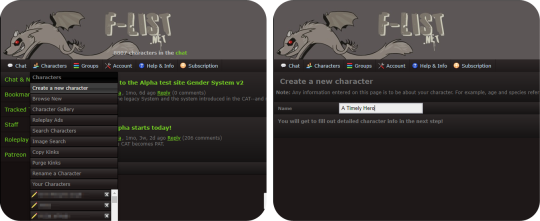
Making a profile, or as they’re known on F-List, a character, is your jumping off point for getting started. There are three main factions on F-List: Anthro Characters, Canon Characters, and Original Characters, with subcategories of each. You also have hub profiles. There is a right way to make a hub profile, but that’s not something I’ll be talking about on this post. Hub profiles are pretty universally disliked on F-List and are often seen as a mark of laziness, and I do not recommend making one to look for RP on. You should make a separate Profile for each character you want to play as. If you have a normal account, you can make up to 150 different characters. If you’re a subscriber, you can make significantly more than that depending on your tier.
Choosing a name for your character is very important! You want something attention grabbing, but since each character has to have a unique name, this can get a little tricky. Today I’m choosing to create a Link from the Legend of Zelda Ocarina of Time. As this is a popular character, it can be difficult to track down a good name. You can be clever with naming conventions, while making it obvious who you’re playing, or you can add in underscores, hyphens, numbers, etc. It’s really up to personal preference. I advise not getting too abstract with your character name. Just pick something easy to read and to the point. Once you’ve decided on a name, click the create character button to open up the character editor.
Step Two: Holy Fuck Dude That’s a Lot of Shit To Fill Out
Take a deep breath. The character editor is very intimidating to those that haven’t used F-List before. Perhaps you have used F-List for it’s old intended purpose, just to list your kinks to link people to when RPing on other sites. Your first instinct might be to scroll down there and start picking kinks willy-nilly. Stop. In the grand scheme of things, this is not as important for getting Roleplay and if you do it incorrectly you might actually hurt your chances.
Now that we’ve calmed down you’ll notice two things at the top of the page. A big white text field, and this guy:

This, more than anything on your profile, is the most important thing. If you have this on profile, you will almost never get any roleplay. This is your character icon, and it’s the first step on your journey to doing this whole thing correctly. All you need to do is find an image that’s 300x300 pixels or smaller and upload it with the Choose File button. Then scroll down to the very bottom of the page and hit save. Search on google, and if you have a hard time finding something of that size, A great site to use is https://lunapic.com/ to edit pics if you don’t have Photoshop or Gimp. Choosing or creating an image with some sort of transparency layer is recommended because it makes your icon look more polished, but you don’t really need to do that. This isn’t an image software guide so I’ll leave that to you to figure out. If all you can do is crop an image into a square, that will do perfectly. But you need to have something here. Besides your character name, it’s the first impression you’re going to give to people when using the site. I have honest to god had people message me on empty profiles that having nothing but a character name and an icon.
Sourcing your images is a bit of a grey area on f-list. It’s not really an art sharing site, but if you choose fanart that someone doesn’t want to be reposted, it can be removed by the mods if you’re reported for it. So we’ll just use some official art that already has a transparency channel and crop it using Lunapic.

Step Three: How To Set the Profile Up
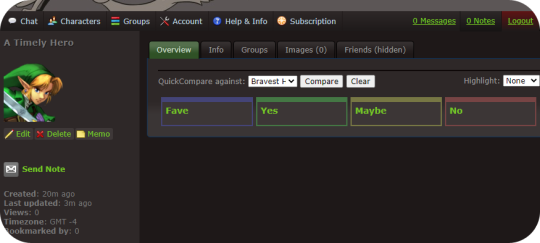
If you’re following along, you should have something like this by now. This already gives us an idea of who you’re playing, and what they look like, and while you might get a couple of weirdos messaging you already, there’s still a lot to do. So let’s go over what to do next.
Now that you’ve already created a character, it will be listed under the character tab. Further characters will be listed in alphabetical order. Navigate to your character and click the “Edit” button underneath their icon.
We’re back to the big scary page. Remember that big text field? We’re going to ignore everything else and focus on this first.
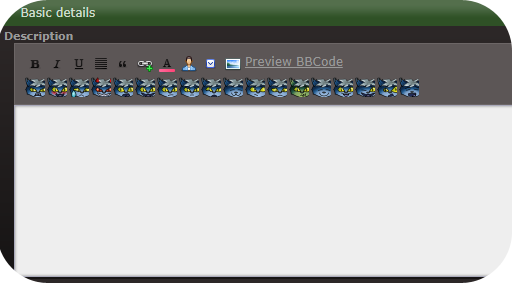
F-List uses standard BBC code tags with [square brackets.] You can find some buttons that will give you tools like bold, italics, color, hyperlinks, and quote blocks. There are many different ways to create eye-catching descriptions. I would say the three basic ways are minimalist, inline based, and heavy BBC code. We’ll go through the first option in detail but if you’re interested in the the latter, there is actually a few F-List profiles that teach coding and even have a few templates to use. User beware, though. Many F-List users use these templates and they can sometimes look a bit generic as they are overused.
Templates: https://www.f-list.net/c/profile%20templates
Coding Help: https://www.f-list.net/c/profile%20references
If you want to make an inline based profile, having access to software like Illustrator, Photoshop, GIMP, and similar content is good to have as well. You can also make a blend of the three styles of profiles. I’ll link some examples of my own profiles for reference. Some of these have text included in the inline. Some of them just have an image with the text written out underneath. Again, it’s really up to your personal preference.
https://www.f-list.net/c/Rival%20II/
https://www.f-list.net/c/Lion%20Heart/
https://www.f-list.net/c/The%20Fire%20of%20Tamaran/
Now would also be a great time to familiarize yourself with the rules. Keep an eye on these, especially if you play contentious content.
https://wiki.f-list.net/Code_of_Conduct
Some big things to look out for and not to do: Photographs and realistic images of animals are not allowed. Even Nonsexual ones. Photographs and 3D renders of minors (even nonsexual images or nonsexual profiles) are not allowed. If there is even a hint of the character being a minor, do not use photographic or 3D renders. (For example: Tom Holland’s depiction of Spiderman. Even though Tom Holland was an adult when he played the role, the character is a minor.) Sometimes these can run into a lot of grey areas, but it’s better safe than sorry!
Step Four: Creating A Minimalist Profile
We’ll start with a short description. It’s really important to make sure your character’s name is present in your descriptio, especially if it’s not the profile name. If you’re feeling particularly lazy, you can copypaste something from a wiki or official description. Let’s start with something like this.
Link had humble beginnings as a boy that lived in the forest with the Kokiri. Known as the boy without a fairy, Link led a simple life until one day, the dying Guardian of the forest, the Deku Tree, set him upon a Quest to save the Kingdom of Hyrule from darkness. Arming himself with the elemental powers of Hyrule and the legendary Master Sword, Link journeyed through time to the Dark Era of Hyrule to challenge the evil Ganondorf and save his Kingdom from evil.
Shoving this into the Description box and hitting save will generate something like this.
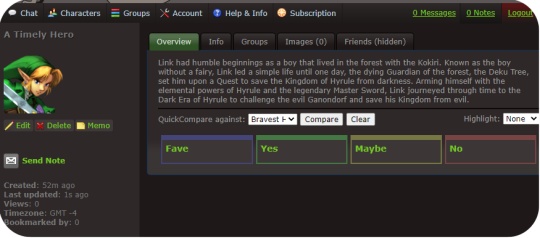
You might notice that this looks like crap. And it does! however, we can very easily fix that with the power of just three simple BBC tags. Those being [center], [color], and [sub]. plus a little something extra I’ll explain in a moment. Let’s add those in like so.
[center][color=green][sub]Link had humble beginnings as a boy that lived in the forest with the Kokiri. Known as the boy without a fairy, Link led a simple life until one day, the dying Guardian of the forest, the Deku Tree, set him upon a Quest to save the Kingdom of Hyrule from darkness. Arming himself with the elemental powers of Hyrule and the legendary Master Sword, Link journeyed through time to the Dark Era of Hyrule to challenge the evil Ganondorf and save his Kingdom from evil.[/sub][/color][/center]
Instead of hitting save at the bottom of the profile this time, we’re going to click “Preview BBC Code” to get a look at what our coding has done.

Fancy.
But it could use a little work. When I’m making minimalist profiles, I like to make the lines of text a little shorter so it’s a little easier to read and looks nicer. Make sure each line of text is about the same length as the previous (minus any BBC tags)
[eicon]blank[/eicon]
[center][color=green][sub]Link had humble beginnings as a boy
that lived in the forest with the Kokiri.
Known as the boy without a fairy, Link
led a simple life until one day, the
dying Guardian of the forest, the Deku
Tree, set him upon a Quest to save
the Kingdom of Hyrule from darkness.
Arming himself with the elemental
powers of Hyrule and the legendary
Master Sword, Link journeyed through
time to the Dark Era of Hyrule to
challenge the evil Ganondorf and save
his Kingdom from evil.[/sub][/color][/center]
[eicon]blank[/eicon]
You’ll also notice that I placed an eicon tag with a “blank” body. Eicons are essentially image macros that can be used all over the site. Using the blank one here is a good way to put a block of empty space on the top and bottom so the text isn’t too crowded by the frame of the description box. Another couple to keep in mind are [eicon]under construction[/eicon] or [eicon]WIP[/eicon] if you want to save your work now and get right to chatting and exploring the site. This signifies that you’re still working on your profile and more will be added later. You can create your own eicons by going to Account > Icon gallery. Keep in mind each eicon must have a unique name across all users. Inputting this into the description and checking how it looks in the preview, we end up getting something that looks like this:
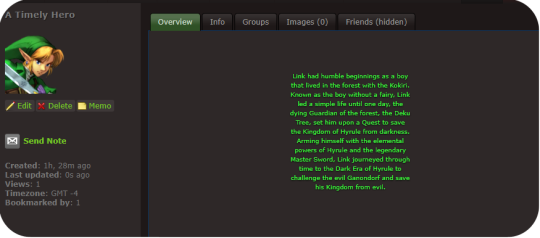
Looks like we got a bookmark while we were setting the profile up. That means someone saw us while browsing new characters and decided they want to keep an eye on our profile and are likely interested in RPing! If you like, you can disable bookmarks per character in the character editor under settings. Generally speaking though, bookmarks are your friend and it’s how people will find you to RP later.
Optionally if you want to add an inline, just upload an image of your choice in Account > Inline Images. You can then add it in the character editor using this button.

This isn’t a tutorial for creating inlines, but a general rule is to make sure it’s sized well, and transparent images tend to look better than non-transparent images.
Step Five: Character Details
Opening the Character Editor once more, a couple basic things should be filled out. We will take this section by section.
Settings: Some general tweaks to change and edit. Personally, I like to turn my timezone off, and besides that, I like to have my Guestbook and Bookmarks turned on as well, but all of these settings are up to you. A big one a I suggest turning on is “Custom Kinks Sort First.” This will come up later but it’s good to turn it on.
Character List: For now, you can ignore this part. You can use this to have certain characters grouped together and will show up in the sidebars of these characters. I haven’t run into any limits for how many character lists you can have, but keep in mind a character can only belong to one list at a time.
Images: If you have any images you want to upload, this is the place to do it. Headcanons of body types, additional art you’ve drawn or found, can be added here. You can add descriptions to each image that will appear when a user hovers over the image. Keep in mind, again, that usage of fan art is a grey area on F-List. It’s not an image posting site, but some artists do not want their art reposted at all.
Profile Info: You don’t need to fill out every single detail here. Bits that aren’t filled in will just not appear on your profile. It’s a good idea to fill out your gender, and in many cases, your orientation. Both are under General Details. Filling out RPing preferences is also a good idea. It’ll keep people from approaching you IC using first person posts if that’s not your thing.
Step Six: Kinks and Custom Kinks
This is probably one of the most overwhelming parts of the process. My first tip: Ignore the Kink section for now. Instead, skip ahead to the Custom Kink section.

Custom Kinks are a good way to tell people what you really want. Click the Add +1 Custom Kink button to make a new custom kink. You can fill out the basic title of the kink, and a description. Or if you prefer to leave the description blank, just press the spacebar. Select what category you want the kink to appear in (Fave, Yes, Maybe, No.) Try to avoid using inflammatory language against different races, genders, identities, and don’t kinkshame. This is a site based primarily around finding rpers that have the same interests and kinks that you do. Save the profile when you’re done and we’ve got something like this.
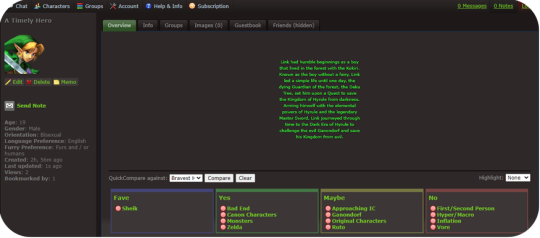
And really, you can probably start roleplaying like this. Maybe add a couple of images, and tweak a few things. So if you like, skip to the next step. But for now, I’ll go over the kink list.
The most important think to remember is you don’t have to add every single kink to your profile. Try to select the most relevant things, and avoid redundancies.
For example, I’m not interested in Vore of any kind. So I can put the kinks Vore (Being Predator) and Vore (Being Prey) Into my No category. Or, if I want to make it even more simplified, I can add a custom Vore kink and put that in my No category. Likewise, if I don’t want to do any sex driven play, I can probably go ahead and just put sex driven there and ignore most of the kink list. Kinks that are not relevant such as Vaginal Sex (Receiving) on a cis male can also be ignored. Kinks are broken up into sections, and while it is a lot, just take your time, go through it sensibly, and take a break if you want to. Remember you don’t have to add every single one to your profile. This will ultimately be easier on you and make your profile easier to read.
After a bit of editing, this is what my kink list ends up looking like:

You can try exploring the Subfetish editor but it’s a little confusing to navigate and isn’t very necessary. And now, your profile is done!
Step Six: Using F-Chat
So now that we have a profile set up, it’s time to find some partners. Regardless of what way you want to connect, if you prefer script or para, the main place you’re going to find RP is through F-Chat. There is currently both a desktop and mobile client. if you select Chat you’ll see the option for both, and clicking on them will take you to instructions on how to set those up. We will however be using the Browser client in this example. Go ahead and select F-Chat 3.0.
You will be taken to a landing page with a drop down of your characters, with the first character you created selected as the default. (You can change your default character in your account settings.) You can have up to three characters online at once. Keep in mind this goes by IP address, so if you have a roommate that also uses F-List, those will count towards your total number of online characters. If this becomes a problem for you, just use a virtual machine or connect to the internet via a different method, such as with data. (F-List is not that much of a data drain.)

Here is what you’ll see when you open F-Chat. You’ll see I already have people in my friends list and my bookmarks (that I’ve blurred out for courtesy.) These will appear the same on all the characters you sign in as. I will be notified whenever one of my friends signs in or sets a status. You can set these notifications to show only on the console if you’d like to in the settings. Let’s set a status first.
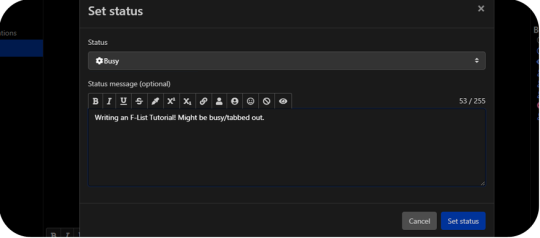
Here, you have the options of selecting from the default Online status to Looking, Away, Busy, and Do Not Disturb. These all do what you’d expect, with Do Not Disturb turning off the sound that would play when you get notifications from personal messages or pings.
The Status Message is an optional addition, and it’s great for if you’re looking for specific things or want your friends and bookmarks to know what you’re doing. Be careful not to post anything that breaks F-Lists code of conduct. F-List does have an aggregate of every status you ever posted logged on their server, so throwing a temper tantrum and posting something inappropriate and then taking it back later might still get you in trouble.
While the Character Search Option is available to you, I’ve personally never found it very effective. You can search users by kinks, but keep in mind it doesn’t search by gender or orientation, or what species or even if they’re canon or original. Instead, we’ll go right to the settings tab.
General: Just your general settings. You have a few options here to tweak and while most of it is personal preference, I’ll highlight a few to keep in mind.
Disallowed BBC Code Tag: good for if you find a particular colour particularly garish as a text colour, or if you find an eicon that you no longer want to see anymore.
Enter Sends Messages: I have this set to off so I can avoid accidentally sending a message for when I post. When this is enabled, just press the send button on screen to send messages. Otherwise, if you want to linebreak in one post, just press Shift + Enter.
Animate eicons: If you’re running a slow computer, or have a slow connection, turn this to off. Eicons are used as memes a lot in F-Chat, and some of them can get a little ridiculous. (Someone has compressed the entire Shrek movie into an eicon and uploaded to the site in very poor quality for example.) There can also be bright flashing colours or even nsfw images. In general these eicons are all 100x100 pixels in size, but some users like to tile them together to create bigger images so it can sometimes get out of hand. This is something up to personal preference, and while I have Animate eicons turned on, I can see why some people wouldn’t like it.
Idle Timer: If you are the kind of person that walks away from your computer without changing your status, or you have fallen asleep with F-Chat open, it’s good to set this to a reasonable time. If you’re in Online or Looking, after you’ve been inactive for the depicted number of seconds, your status will be set to Idle. This is so other users know that you’re not ignoring them if you don’t respond to their messages. A downside to this is if you’re tabbed out or multitasking, it’ll set you to idle when you may not intend it to and going back to the window switches you to Online again. It can be a little spammy if you’re constantly switching between Online and Idle.
Font Size: If you find F-Chat’s font too big or too small, you can edit that here.
Notifications: While this section is pretty self explanatory, I’d like to specifically go over the Custom Highlight Notify Words.
Now, because each profile has to have a unique name, you might want to select additional pings. For example I might want to add Link,Zelda,Hyrule,Hero,Hero of Time to my list. Everything is comma seperated and not case sensitive. There are a few things to keep in mind.
Common word pings: If I add Link to my list of pings, I might get pinged whenever someone talks about a url link, or a chain link, or any other common use of the word link. It therefore might be better to not use the word. If you have a profile name that is a common word, it might be better to also uncheck the option for Notify Messages Containing your name.
Similar Profiles: If there’s another Link in chat, then I will be notified everytime someone refers to him by name as well. This is less of a problem on more niche characters, but it’s something to keep in mind! You can set pings by room, so perhaps a solution to this is using Link as a highlight word in the Canon Characters room, but not using it as a highlight word in the Nintendo room. More about how to do that later.
Hidden Users: Pretty self explanatory once click over. If you keep seeing an ad you dislike, you can hide all advertisements from said user (re: character) going forward. Keep in mind this is not your block list.
Import: If you make two profiles and want to have these settings copied from one to the other, just log into the profile you want to import to, and select the profile you want to import from. Make sure to go back to change your pings if needed.
Lastly, we’ll be looking at the channel section.

You might be starting to be overwhelmed again, and that’s okay. There are a lot of options, but most of the time, you’ll only want to select the options that are relevant to us. Check off the list of rooms you want to open a tab for. These will begin to be added to your sidebar. the number in brackets signifies the number of users thats joined that room. By default, this list is most popular to least popular, but I personally prefer alphabetical. There may be some channels that you find inappropriate, offensive, or contentious, but your best bet is to ignore those parts of the site. It’s an Adult site that is heavily moderated by a mixture of paid and volunteer staff. Every effort is made to ensure that no real people get hurt, but it is understood that as an adult, you are responsible for curating the content that you consume. This is one of the fundamental principals that F-List is built upon.
For now, I’m going to go with Canon Characters and Canon Characters OOC from this list.
You will also notice an Open Room tab. Unlike the Official Channels which are moderated by F-List staff, Open Rooms are chat rooms created by the userbase, and moderated by the userbase. While the standard F-List code of content is applicable to all areas of the site, special rules may apply in these rooms, and you’ll find things like rooms dedicated to certain kinks, species, and fandoms. I can try searching for a few things I think might be applicable to me, such as Hyrule, Zelda, Nintendo, and Elf. Some of those get hits, and some of those don’t. I can also check them off to add them to my list. (Note that search terms have to be entered one at a time. I cannot search for multiple things at once.)
Once you’ve selected the channels and rooms you want to join, you can click and drag on the tabs to reorder them on the sidebar. If you’d like to pin a chat, You can just press the little push pin symbol, which will then turn green. (You can do this for User Messages as well.) This means when you sign out, these chats will still be there when you sign back in. Note that settings and pinned chats are device by device only, and furthermore, channels and logs will not carry over between characters.
Make sure to read the description of each room you join. There are often specific rules (such as no ooc talk in the canon characters room, and no male characters in the lesbians room.) Clicking the gear will allow you to change settings on a per-room basis.
Step Seven: Actually Finding some RP
Now, after all that effort, we’re finally ready to find some RP. You have a few options on how to do this.
You could just join a few rooms and set your status to looking with a status message on what you want, but this is considered very passive. You may get some people that reach out (As you saw, someone had bookmarked my Link less than an hour after I made the profile before logging into f-chat.) But your best bet is one of three options.
Look at the Ads: Whenever you’re in a room that allows ads, you will sometimes notice a differently coloured message fly by looking for roleplay. This is an ad. If you see one that seems to fit what you have to offer, you can right-click on their username and select “Open Conversation.” A chat window will be open under the PMs section on your sidebar. You can view this conversation like you would a channel. Keep in mind that users are not notified if you open a conversation with them, only if you send them a message.
Create an Ad: Make sure you are in a room or channel that allows ads by checking the description, you can select the ad tab in the lower right hand corner above the text input box to write an ad instead of a chat message.

Making a normal chat post saying “hey does anyone want to roleplay with me” is considered spam and could result in the mods having a word with you.
You have similar tools to what you do in the character descriptions, and clicking each one will automatically place the tags in the text box, with the eyeball being a preview and the question mark being a how to. You want your ads to stand out, but you don’t want them to be too obnoxious. Take a look at what kind of ads other people are posting to get an idea of what’s expected.
Talk to Others: And lastly, you can just play in public rooms or chat with people in ooc channels. This is a great way for others to sample what you’re like to play with and vice versa, or even just to get to know potential partners. In my general experience, you’ll have more luck finding people to play with long term in the user created Open Rooms than in the Official Channels, but ever case is different. There are a vast number of styles, methods of RP, and types of partners you can find.
That’s basically the ins and outs of F-List! The more you’ll use it, the more you’ll understand how it works and the social etiquette on the platform. Like many sites, it certainly has it’s share of dark corners and flaws, but all in all it’s a pretty good website to find people to play with! Have fun!
#cherp#mxrp#rp#tumblr rp#flist#no tea no shade for tagging other RP sites#just giving people more options and I've been asked about it a few times
60 notes
·
View notes
Text
Five* Outside albums of 2020

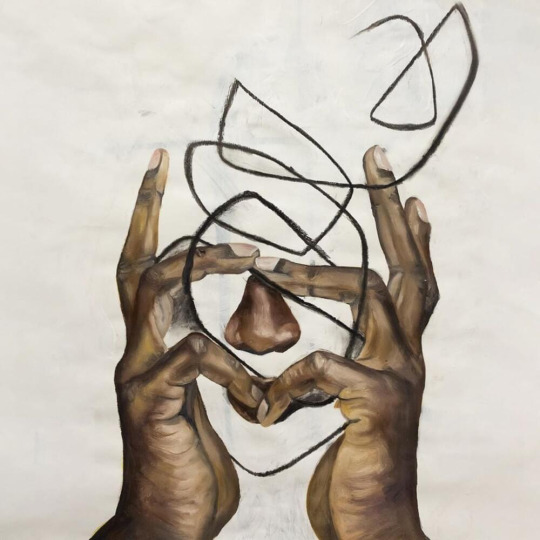



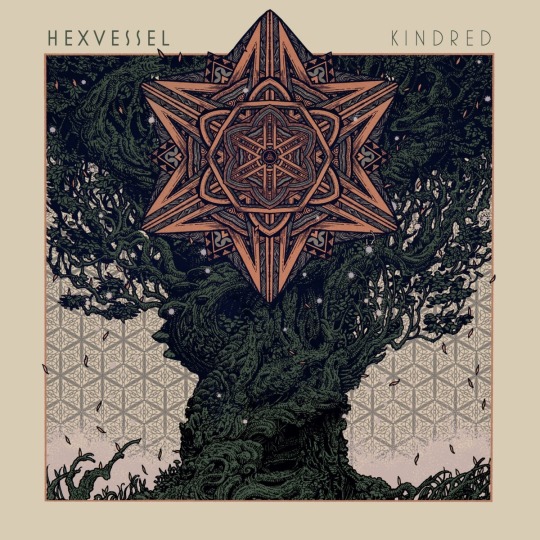
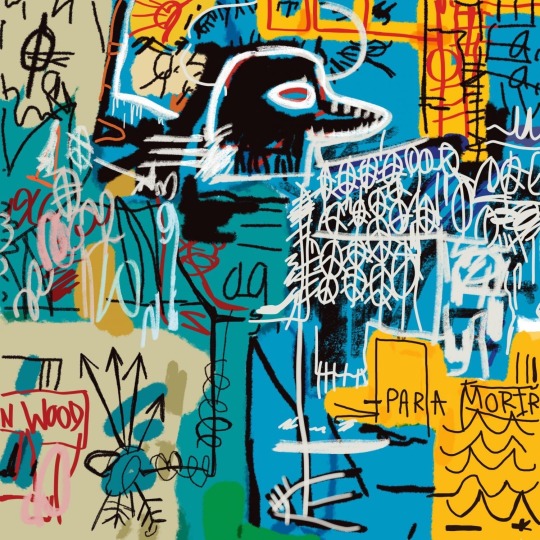

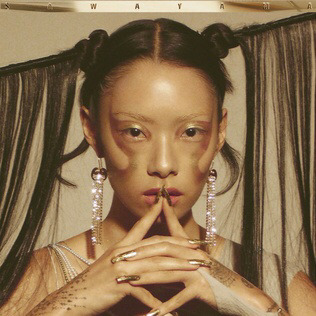

I do this little list every year of my favorite albums that fall mostly “outside” the metal sphere and weren’t so metal-adjacent that I reviewed them formally during the year. The past three times I have written this little piece, I have kept it to five, but *this year, I’ve just had a hard time narrowing it down, so I figured, why do that? Well, I could go through a few dozen albums or so that I fucked with this year outside the metal sphere, but I’m compromising with the addition of a new, quick (we’ll see) honorable mention section.
So, in the interest of keeping my verbose tendencies in check, I’ll cut this introduction off and get into the honorable mentions.
Honorable Mentions:
Anna von Hausswolff - All Thoughts Fly
I did review Anna von Hausswolff’s previous record, Dead Magic, back in 2018 as part of my bunch of metal albums reviews that year, because it was kind of tangentially metallic. It wasn’t a lot at a technical level, only a few metallic elements here no there, but it had a lot of harrowing qualities that I thought metal listeners might appreciate. For the Swedish singer and pipe-organist, that album really was the closest she ever came to metal’s territory, and I don’t think any flirting with the genre was intentional on her part. Most of what she does is haunting, neoclassical, organ-based music that’s usually not as wild as what Dead Magic was, and this year’s album is a real scale back to her roots and an appreciation for the pipe organ. While I do miss her bewitching vocals on this entirely instrumental album, All Thoughts Fly stands well on its own merits as both a solid tribute to von Hausswolff’s organ playing and as a beautiful, incredibly immersive ambient album that does so much with its relatively small palette. I’ve talked a few times on here about really shitty ambient music that’s approached with a clearly lazy attitude because of its supposed background role. Rather than being made to be ignored, All Thoughts Fly pulls you in and around in a swirl of lush sounds that aren’t too common in ambient music, and with a relatively minimal approach, relying on the naturally serene tambre of the instrument to fill the space with a lightening, floating ambience and well-structured movements to do the gentle moving. It’s a beautiful example of what an ambient album can achieve if it’s actually made with a lot of love and care.
Shabaka & The Ancestors - We Are Sent Here by History
Okay, that first one went pretty long. I’ll try to keep the rest of these here relatively short. Sons of Kemet band leader, Shabaka Hutchings, takes his other group on slightly less chaotic Afro-jazz odessey that what Sons of Kemet have been delivering us. While more contained on the surface within the genre’s usual light grey areas, Shabaka & The Ancestors move with freedom and flexibility on this album in a way that highlights the natural appeals of the Afro-jazz sound pallet through constantly engaging arrangements from masters of the craft.
Lady Gaga - Chromatica
I know we’re all well aware of Lady Gaga, but the pop icon has been relatively quietly been making the best music of her career since taking the edge rather than the center of the spotlight, from 2013’s diverse Artpop to 2016’s more bare-bones Joanne. And now, after her mellower, more traditional Americana-influenced album in 2016, Gaga cranks the volume and the fun way back up. Chromatica is a blast of an album whose wide span of dance pop albums influences new and old keeps it varied and lively all the way through. This album feels very much like it’s Gaga unleashed, just doing her thing and having a good time with a bunch of dance music styles that she’s always loved, and it’s impossible not to feel that enthusiasm secondhand, and groove the hell out along with it.
Black Thought - Streams of Thought, Vol. 3: Cane & Abel
Black Thought has had nothing to prove since the relative inactivity of The Roots this past decade, but he has sure been rapping as if he does have something to prove on his solo work. The Philadelphia rapper put out a couple of EPs back in 2018 that showcased his impressive modern lyricism and flow, and the third, LP-sized installment in the series is just another offering of further proof of the man’s lyrical chops. There’s a little bit of an understated delivery in the music overall, but Black Thought really lets his words speak for themselves more than his moderate bravado. It’s not super flashy because it doesn’t need to be.
Phoebe Bridgers - Punisher
Indie folk has always loved to soak in the puddles of personal sadness, but Californian singer Phoebe Bridgers takes the style to whole new depths of personally gripping, bordering on the outright emo, and that is by all means a compliment for rather than a shot at. The album’s candid journaling of Bridgers’ personal struggles is so tangible and so genuine that it would probably rival Connor Oberst’s best work with Bright Eyes. It is just a beautiful, yet tear-inducing album.
Alright, now on to the five “main” “non-metal” albums of the “list proper”.
Hexvessel - Kindred
Hexvessel are a Finnish six-piece whose sixth album of psychedelic folk here manages to touch on the same haunting, gothic tones that groups like Opeth and Gazpacho do at their most forest-y. Indeed, Kindred is an enchanting album, with sprawling styles and a full-bodied sonic pallet to keep it interesting the whole way through. And it’s as strong in its more bombastic song like that which opens the album as it is in its more stripped back acoustic tracks like that which closes it. Songs like “Magical and Damned” straight-up evoke Mount Eerie, while songs like “Kindred Moon” hearken to The Beatles at their most minimal and folky, and there’s plenty of spooky, mystical energy to go around. Definitely one of the best finds of the year for me.
The Strokes - The New Abnormal
Coming at the end of a seven-year gap between it and their previous album, 2013’s somewhat fan-polarizing Comedown Machine (which I liked a lot), The Strokes’ aptly named return is a return to the spotlight, but hardly to normalcy or the musical roots in garage rock that so many of the band’s fans have been sweating for. Twisting the electronic alternative rock of their Angles era into some odd, but mesmerizing forms, The New Abnormal is a subtly wild ride of an album through lots of melancholic overtones and undertones whose impact is made all the more potent by the occasional teasing of sorts with the few more traditionally rockin’ moments on here. It doesn’t take long to pull back the seemingly preppy synth rock or 80’s rock curtains to find the melancholy beneath “Brooklyn Bridge to Chorus” and “Bad Decisions”, respectively. But the band aren’t even that subtle with the immediate depression of just the straight-up guitar melodies on songs like “Selfless”, “Not the Same Anymore”, and the chill-inducing soar of “Ode to the Mets”. The album’s prize piece, though, has to be the utterly gorgeous and empathetic minimalist synth song, “At the Door”, whose simple melodies and bare delivery make for one of the most gently heart-piercing songs I know and of my favorite songs of the year and probably my favorite Strokes song ever, as hard as it is to listen to. Welcome back Julien and company.
Rina Sawayama - Sawayama
Quite possibly the best outright pop album I have heard in a long while, Sawayama sounds simultaneously fresh and vintage in the landscape it was born into, making use of a lot of early 2000’s pop rock instrumentation, even some heavy metal guitars here and there, but most importantly, a real sense of passion that seems to be flat-out absent from so much of the pop that I (usually inadvertently) hear. I don’t want to overstate the prominence of the metal elements, but the album does have a bubbling, infectious energy both vocally and instrumentally from front to back that the occasional bursts of heavy guitars between Sawayama’s charismatic, dance-inducing performances do provide a good snapshot of. Furthermore, there’s a rich diversity of song types across the album that dive into the pop sphere beyond the standard trend-hopping that dominates streaming playlists and make for a dynamic and fun, rather than disjointed, pop album. And that’s all only possible with the consistently tight compositions o the album. Indeed, this is one of the best pop albums I have ever heard, certainly in recent years.
clipping. - Visions of Bodies Being Burned
clipping. are the second artist to be on here two years in a row after last year’s spectacularly spooky There Existed an Addiction to Blood, and Denzel Curry’s one-two punch of TA13OO and Zuu in 2018 and 2019 respectively. There Existed an Addiction to Blood was a thrilling and fresh take on many tropes of horrorcore with the band’s already forward-thinking and creative noise-driven instrumental production guiding harrowing stories of femme fatales and street violence in a more modern setting that often flipped the script on victims and perpetrators, as well as settings themselves. Visions of Bodies Being Burned is quite literally a continuing sequel to that explosive album, also released in time for Halloween this year; the material was recorded in the same sessions as the previous album and in the same unique vein. Consequently, there’s not really a whole lot I can say about this album in contrast with the last without getting way too in-depth and spoiling the fun. Whereas MC Daveed Diggs’ hooks were one of the biggest strong points of last year’s album, the creatively noisy production is the big star on this album. The fans seem to be leaning a bit more toward this year’s release, but I think I’m still a little partial to There Existed an Addiction to Blood. Nevertheless, Visions of Bodies Being Burned is a blood-pumping follow-up not to be missed.
Mac Miller - Circles
The posthumous release from Pennsylvanian rapper Mac Miller captures the man at his most chill and contemplative. The album is more of a minimalist ambient singer-songwriter sort of album than hip hop and its serene atmosphere becomes kind of inadvertently tragic in the posthumous context, but it serves as a beautiful swan song for the creative rapper whose struggles with addiction sadly prevented him from being able to bask in the deserved wide appreciation of his sixth album. Circles is a soulful, bittersweet cap to Mac Miller’s legacy that I think anyone will be able to feel the love and raw humanness of.
#Black Thought#Streams of Thought#Streams of Thought Vol 3#Anna Von Hausswolff#All Thoughts Fly#The Strokes#The New Abnormal#Hexvessel#Kindred#Rina Sawayama#Sawayama#Phoebe Bridgers#Punisher#Lady Gaga#Chromatica#Shabaka and the Ancestors#We Are Sent Here by History
22 notes
·
View notes
Photo
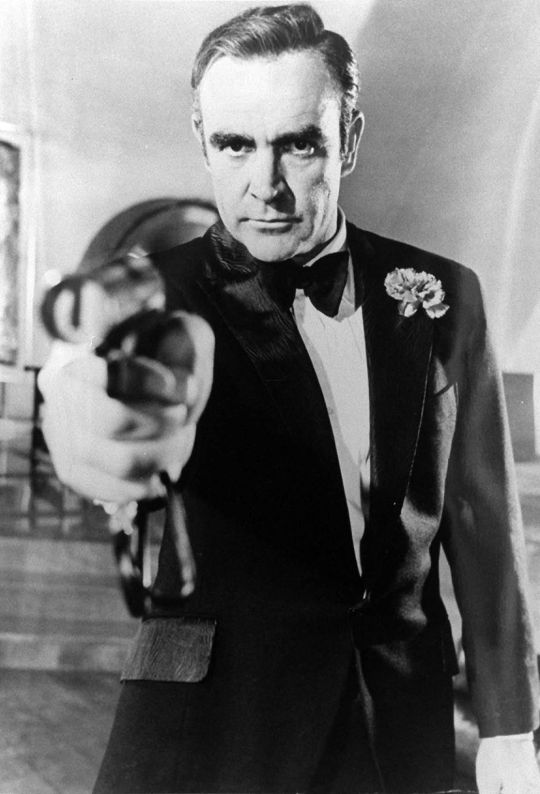
Sean Connery, Oscar Winner and James Bond Star, Dies at 90
Sean Connery, the Scottish-born actor who rocketed to fame as James Bond and became one of the franchise’s most popular and enduring international stars, has died. He was 90.
Connery, long regarded as one of the best actors to have portrayed the iconic spy, was knighted by Queen Elizabeth II in 2000 and marked his 90th birthday in August. His death was confirmed by his family, according to the BBC, which notes that the actor died in his sleep while in the Bahamas. It’s believed he had been unwell for some time. His last acting role had been in Stephen Norrington’s “The League of Extraordinary Gentleman” (2003).
Connery was an audience favorite for more than 40 years and one of the screen’s most reliable and distinctive leading men. The actor was recently voted the best James Bond actor in an August Radio Times poll in the U.K. More than 14,000 voted and Connery claimed 56% of the vote. Global tributes poured in for Connery on Saturday following news of his death.
In a statement, Bond producers Michael G. Wilson and Barbara Broccoli said Connery “was and shall always be remembered as the original James Bond whose indelible entrance into cinema history began when he announced those unforgettable words, ‘The name’s Bond… James Bond.’
“He revolutionized the world with his gritty and witty portrayal of the sexy and charismatic secret agent. He is undoubtedly largely responsible for the success of the film series and we shall be forever grateful to him,” said the producers.
However, Connery — who made his debut in the first Bond film, “Dr. No” (1962) — also transcended Ian Fleming’s sexy Agent 007, and went on to distinguish himself with a long and mature career in such films as “The Wind and the Lion” (1975), “The Man Who Would Be King” (1975) and “Indiana Jones and the Last Crusade” (1989).
His turn as a tough Irish cop in Depression-era Chicago in Brian De Palma’s “The Untouchables” (1987) brought him a supporting actor Oscar.
Even as he entered his seventh decade, Connery’s star power remained so strong that he was constantly in demand and handsomely remunerated. In 1999 he was selected People magazine’s Sexiest Man of the Century, and from his 007 days to “Entrapment” (1999), opposite the much-younger Catherine Zeta-Jones, his screen roles more than justified the choice. Age seemed only to intensify his sex appeal and virility.
In his early career, his physique was his main asset as he modeled and picked up acting jobs where he could. In 1956, he landed the role of a battered prizefighter in the BBC production of “Requiem for a Heavyweight.” Good notices brought him to the attention of the entertainment community, and his first film was “No Road Back,” a B crime movie in 1956. He seemed doomed to play the hunk to ageing leading ladies, as he did opposite Lana Turner in “Another Time, Another Place,” or roles that stressed his looks such as “Tarzan’s Great Adventure” in 1959.
It was easy to dismiss him in films like “Darby O’Gill and the Little People,” but his Count Vronsky to Claire Bloom’s Anna Karenina on the BBC brought him some respect and the kind of attention needed to raise him to the top of the Daily Express’ poll of readers asked to suggest the ideal James Bond.
After an interview with producers Albert Broccoli and Harry Saltzman, he landed the role without a screen test, according to Saltzman. It was a controversial choice at the time, as Connery was an unknown outside Britain. But 1962’s “Dr. No,” the first of the Bond films, made him an international star.
His stature grew with the ever more popular sequels “From Russia With Love,” “Goldfinger” and “Thunderball,” which arrived over the next four years. Bond gave Connery a license to earn; he was paid only $30,000 for “Dr. No” but $400,000 for Alfred Hitchcock’s “Marnie” and was soon getting $750,000 a film.
His initial efforts to break out of the Bond mold, however, proved fruitless. Films like “A Fine Madness,” “Shalako” and “The Molly Maguires” were well-intentioned attempts that did nothing to shake Connery as Bond from the public consciousness. After 1967’s “You Only Live Twice,” he left the Bond franchise, but he was coaxed back for 1971’s “Diamonds Are Forever.” He looked old for the role, and the series seemed tired, so with that, he left Bond behind — though money would tempt him back once last time in 1983 for “Never Say Never Again.”
He took a major misstep with sci-fi film “Zardoz,” and his career seemed to be foundering.
But he bounced back in 1974 with a supporting role in “Murder on the Orient Express” and the following year with “The Wind and the Lion” and “The Man Who Would Be King,” two bold adventures featuring a mature, salt-and-pepper-bearded Connery. “Robin and Marian” (1976) opposite Audrey Hepburn was not a popular success, but critics embraced it, and the film cemented Connery’s reputation as a versatile, serious screen actor.
In the late 1970s, there were more missteps such as “Meteor,” “A Bridge Too Far” and “Cuba.” But he scored in Terry Gilliam’s “Time Bandits.” It wasn’t until after his last Bond film that his standing as a box office star caught up to his critical reputation, thanks mostly to two huge worldwide hits: “Highlander,” which was not a big hit in the U.S., and “The Name of the Rose,” which was also much more popular abroad.
BAFTA gave him a best actor award for “Name of the Rose,” and he received his Oscar for “The Untouchables.” After that, he was an instant greenlight any time he agreed to take a role even if some of them, such as “The Presidio,” and “Family Business,” were not so hot.
Pairing Connery and Harrison Ford as father and son in the third “Indiana Jones” film was an inspired move, and the film grossed almost half a billion dollars worldwide.
Meanwhile, “The Hunt for Red October,” in which Connery played a defecting Soviet sub captain, was also a major hit in 1990.
By the 1990s, he was so popular that his uncredited cameo as King Richard in “Robin Hood: Prince of Thieves” became one of the film’s highlights.
He was still a force to contend with in the foreign market, as “Highlander 2,” “Medicine Man,” “Rising Sun,” “Just Cause” and “First Knight” proved over the next several years. His salary was regularly $5 million and above.
One setback was a bout with throat cancer in the early 1990s, but Connery rebounded with a burst of activity. He starred with Nicolas Cage in 1996 actioner “The Rock,” playing a character that drew more than a little on his history as James Bond. In 2000, he essayed a very different role and received positive reviews for “Finding Forrester,” playing a reclusive writer who bonds with a young black basketball player who’s an aspiring scribe himself.
Nevertheless, he continued with action roles well after his 70th birthday, playing the legendary adventurer Allan Quatermain in 2003’s “The League of Extraordinary Gentlemen.” He announced his retirement in 2005. He voiced a James Bond videogame the same year, and he subsequently did some other voice acting, playing the title character in the animated short “Sir Billi the Vet” and reprising the role in 2010 for “Sir Billi,” which he also exec produced.
Thomas Sean Connery was born of Irish ancestry in the slums of Edinburgh on Aug. 25, 1930. Poverty robbed him of an education, and by his teens he’d left school and was working as an unskilled laborer.
At 17, he was drafted into the Royal Navy, but he was discharged three years later due to a serious case of ulcers.
He returned to Edinburgh and worked a variety of jobs, including as a lifeguard. He took up bodybuilding and placed third in the 1950 Mr. Universe competition.
After moving to London, he learned of an opening in the chorus of “South Pacific.” He took a crash dancing and singing course and, surprisingly, landed the role, in which he stayed for 18 months. He was “hooked,” he said, but spent several years paying his dues in small repertory companies in and around London before anyone else became hooked on him.
Connery was devoted to his native Scotland and used his stature to press for the re-establishment of a Scottish parliament. When the body reconvened in 1999, 296 years after its last meeting, Connery was invited to address the first session, where he was greeted with a thunderous ovation. The next year, when he was knighted by Queen Elizabeth II — an honor he called “one of the proudest days of my life” — he asked that the investiture be performed in Edinburgh.
Connery published his autobiography, “Being a Scot,” co-written with Murray Grigor, in 2008. Besides his knighthood and his Academy Award, he received many kudos over his long career, including the Kennedy Center Honors in 1999 and the American Film Institute’s lifetime achievement award in 2006.
Connery was married to actress Diane Cilento from 1962-73. The couple divorced in 1973 and Cilento died in 2011. Connery is survived by his second wife, painter Micheline Roquebrune, whom he married in 1975; his son by Cilento, actor Jason Connery; and a grandson from Jason’s marriage to actress Mia Sara.
Daily inspiration. Discover more photos at http://justforbooks.tumblr.com
36 notes
·
View notes
Text
The Road To “Godzilla VS. Kong”, Day One
KING KONG VS. GODZILLA (AMERICAN VERSION)

Originally Released: June 26th, 1963
Director: Ishiro Honda
Writers: Shinichi Sekizawa, Paul Mason and Bruce Howard
Starring: Tadao Takashima, Kenji Sahara, Ichiro Arashima, Mie Hama, Michael Keith, Harry Halcomb
youtube
“King Kong VS. Godzilla” is a movie whose reputation often precedes it amongst certain circles of Genre Film fans. Even if one is unaware of the convoluted, more than slightly seedy story behind its creation (short version: the original “King Kong”’s special-effects artist, Willis O’Brien, was interested in creating a sequel that would have pitted Kong against a giant animalistic version of the Frakenstein Monster, but shady producer John Beck wound up stealing the idea and, when American studios balked at the project for fear that the use of stop-motion animation to realize the effects work would be too expensive, wound up shopping it to the more cost-effective Toho Studios in Japan, who reconceived it as a new “Godzilla” project in hopes of revitalizing interest in the character), it is still one of the most singularly important Giant Monster Movies ever made. For one thing, it basically defined The Kaiju Movie as we know it today; sure, the original “Gojira” from 1954 (and by extension its Americanized adaptation, “Godzilla: King of the Monsters” in 1956) may have effectively created the genre, but you’ll notice the majority of such movies that exist today are more about Fanciful Title Bouts between two Clashing Monsters rather than somber moody Allegories about the horrors of Nuclear Weapons. For another, it’s the movie that really put Godzilla himself on the map as a Big Star in his own right; at the time, he only had two prior films to his name, and while one of them was the aforementioned genre-creating watershed “Gojira”, the other was “Godzilla’s Counterattack” from 1956, which proved such a box-office disappointment that it put the character into retirement for the better part of a decade (and to give you a sense of just how much less weight the name “Godzilla” carried back then, when that movie was released in America in 1959, it was initially re-titled “Gigantis The Fire Monster”). With “King Kong VS. Godzilla”, however, he would begin to star in more and more movies, building a film franchise that continues to this day.
So it’s a bit of a shame that I’ve never liked it all that much.

To be clear, the “it” in question here is specifically the American version of the movie, which is the one most Western audiences would be familiar with since, until recently, it was the only one readily available to us (though Criterion finally corrected that back in 2019, when they included the original Japanese version of the movie as a bonus feature in their “Showa Era” collector’s set). Certainly, it’s the one that I grew up watching as a kid, when my mom, ever so protective and knowing how easily upset I could be when Fictional Characters I Loved got hurt, made sure to watch ahead to see who exactly won the title match-up (and since it was Kong, I wouldn’t actually get around to finishing my viewing of the movie for a good long while). Back then, of course, I viewed it very much through that childish prism of who I thought should win, and it was exactly the kind of Schoolyard Logic you’d expect: Kong was supposed to be a great deal smaller than Godzilla, and where Godzilla had his iconic fire breath, Kong had no extraordinary powers; Kid Me understandably concluded that this match-up really ought to be a shoe-in for Godzilla, which worked out well since Godzilla just so happened to be the one Kid Me actually cared about. Kid Me was thus quite irritated to discover that, for the sake of this movie, Kong had in fact been significantly sized up and given random electricity-absorbing powers. It felt like cheating to Kid Me, and it left me less than positively disposed towards the film proper.
These days, of course, I’m able to give the film a somewhat fairer shake, though I would be lying if I said that My Inner Childish Fan-Boy is completely quiet on the matter (in particular, it always bothers me that, to emphasize the advantage Kong’s electrical powers give him in their fight, the movie explicitly cites Godzilla’s “vulnerability” to electricity, despite one of the most singularly iconic images of the original “Gojira” being his ability to walk straight through a power-line barricade). Indeed, my most recent re-watch for this very review honestly left me feeling fonder toward it than I was even on my last most recent re-watch (back in 2014, in preparation for the then-upcoming Gareth Edwards “Godzillla”, which we’ll also be getting to in this re-watch soon). The portrayal of the title monsters themselves in particular left me much happier this time around than it has in the past; the design for Godzilla himself- thick around the center with big heavy-browed eyes and what appears to be a constantly self-amused grin, huge sharp claws that dominate the fingers and a tail that moves with a real sense of weight and purpose-took me a long time to warm up to, for example, but these days I would happily cite it as one of the very best of the original series. Kong gets it a bit worse, sadly; the suit they design for him here (a fact that original “Kong” director Merian C. Cooper openly despised, incidentally; the idea of portraying Kong as just some guy in a gorilla costume was one of the things he explicitly set out to avoid in the original movie) has a distinctive enough face if not an especially memorable one, but the costume always looks and feels a bit raggedy, with the sagging pecs and ill-fitted arms (throughout the movie the suit switches between “regular” arms designed to allow the actor mobility, and extended arms to help give it a more ape-like gait; the result is that both versions feel weirdly out of place on the costume a lot of the time) looking especially awkward. However, even beyond how they look, the way the monsters act is genuinely enjoyable, with Haruo Nakajima as Godzilla and Shoichi Hirose as Kong both putting in fantastic performances that imbue them with a great sense of personality that is just consistently delightful all movie long. Whether it’s Godzilla hopping around, arms flailing in triumph whenever he manages to pull off another victory, or Kong drunkenly swallowing up giant pots’ worth of a narcotic usd to keep him docile, the movie very visibly delights in imbuing these creatures with fun foibles, and It’s no coincidence that the it’s at its strongest, not so much when the monsters are fighting, but when they are simply interacting as actual Characters: Godzilla here feels often like a particularly arrogant, boundlessly-energized child, while Kong is a bit more confused and subdued but quick to anger when irritated; their first meeting, when both these strong visible personalities most openly bounce off each other, is unquestionably my favorite moment of the movie.
The rest of it isn’t exactly bad, per se, but it is a lot less entertaining. Some of that is simply what the American version inherited from the Japanese original, not least of all the noxiously racist portrayal of the Natives living on a remote pacific island with Kong (here named “Faro Island” for some reason instead of the usual “Skull Island”). On top of the sins it recreates from the original “King Kong” (a fairly ooga-booga understanding of What Islanders Are Like, all of whom are portrayed by non-Native actors slathered in brownface make-up), it also includes a decently insulting bit wherein the initially-hostile islanders are pacified by the introduction of “magic” in the form of a hand-held radio and cartons of cigarettes. There’s also the fact that the plot is driven almost entirely by Random Contrivance rather than anything that flows naturally from either the characters or the premise; Godzilla and Kong have no real compelling reason to meet, let alone fight, other than the pure coincidence of their both happening to be active at around the same time in the same part of the world (the American version attempts to ameliorate this somewhat by stating that the two are “instinctive rivals” who will be “naturally driven to destroy one another”, but that flimsy lip-service to Motivation just winds up making the otherwise-arbitrary plotting feel all the worse), and we are constantly bombarded by Total Coincidences as a way of shuffling the characters around from place to place with dizzying frequency. But some of those troubles are only exacerbated by the approach the American version has taken to the material. We’ll talk about this more tomorrow, but the Japanese “King Kong VS. Godzilla” is, at heart, a Satirical Comedy; this, unsurprisingly, was not an idea that went over well with Universal Studios in America, who chose to try and reshape that comedy into a more traditional Monster Movie. An understandable objective, but not one the Japanese cut of the film made easy to achieve; to avoid the most overt Comic bits meant cutting almost all of the human characters in the film (most notably the eccentric executive Mr. Tako, played by Ichiro Arishima) down to only their most essential appearances, which in turn means that they all wind up feeling vaguely undefined and out of place in their own story (this feels especially true of our ostensible main character, Tadao Takashima‘s Sakurai, who is present enough to FEEL like a main character but has little left to do in this cut of the film). To make up the weight of all that cut footage, meanwhile, we get gobs of new footage consisting mostly of Michael Keith as a United Nations reporter talking at us in the most stultifying way possible, often joined by Harry Holcombe as an equally stultifying scientist (who apparently gets his knowledge of dinosaurs primarily from children’s picture books, which in fairness would explain a lot of the nonsense he ends up saying), though he also frequently talks with a fellow reporter played by James Yagi. These scenes are not, perhaps, without their charms, but they also deaden the movie’s pacing, especially since nine times out of ten they exist mostly to reiterate stuff we already know because it literally just happened. Given how much a faster pace seems to be one of the American cut’s top priorities (a sub-plot from the Japanese version about a submarine inadvertently encountering Godzilla is reduced to a single sequence for this version), that choice proves a counterintuitive one.
Because the other major problem with the American approach to this movie is that, to be frank, the Monster Action is nowhere near Epic enough to bear the weight this new cut puts on it. Again, it’s not without its merits; Godzilla and Kong’s outsized personalities do a lot to lend even the less effective sequences a certain fun spirit, and there is still an unmistakably strong sense of craftsmanship to the miniatures used throughout the movie to create the appropriate sense of scale for our Monsters to play around in (the demolition of a recreation of Atami Castle shines a spotlight on that very fact). But in terms of both their scope and their choreography, there’s just not enough There there; far too often, “King Kong VS. Godzilla”’s Big Marquee Action Scenes amount to the monsters just sort of lazily throwing rocks at each other, or else engaging in less-interesting recreations of their previous Iconic Moments (Kong especially goes through a truncated version of his original appearance’s third act, though here he ends up on top of the National Diet Building rather than the Empire State Building). That’s slightly less of a problem in the Japanese version; again, there, the main thrust of the film lies in its comedy, and thus the Monster Action being relatively lightweight is less of a hinderance and more a spicy Flavoring to the main story. But here, it is the main story, and while it’s pretty clear some real love went into the Effects Work (the puppetry especially is very solid; there are a few instances where the switch from Suit Actor to Puppet for Godzilla is borderline seamless, and I also enjoy the decently-animated feel of Kong’s facial puppet as well) it ultimately doesn’t have nearly enough substance to fill that role. This comes through especially clearly in the Final Showdown between the monsters; again, there is some deservedly iconic stuff here (Kong trying to shove a tree down Godzilla’s throat only to have it rebuffed in a puff of flames has become an impressively-enduring Meme for a reason) but, much like most of the story, winds up being driven far more by Contrivance than anything clever or satisfying (a bit where Kong knocks himself over feels especially annoying for how unmotivated it seems to be). It was always going to be a tall order to make a match-up with as much implicit weight to it (both metaphorical and literal) live up to the heightened expectations placed on it, maybe. But even taking that into account, it’s hard not to feel like “King Kong VS. Godzilla” could have put a little more effort into things.
Still, I was saying, at the start, that I walked away from “King Kong VS. Godzilla” happier this time than in many of my past viewings. And that is ultimately true: for as much as I find myself often wishing it could be a different movie, the movie it actually is already does manage to work decently well on its own terms. The dub-work here in particular honestly deserves notice; in contrast to the standardized casts Toho would start using for most of its “Godzilla” movies moving forward, here we get a more distinctive sounding voice-cast who manage to put some real Life into their performances (the voice they give to Kenji Sahara’s Fujita stands out especially to me, nasally and over-earnest but capable of some real Fire when the moment calls for it, as befits the character). And, again, whatever my beef with the Action Scenes, the actual portrayal of the Monsters really is uniquely fun (indeed, given how many other elements Toho would consistently crib from it, I’m often surprised that Godzilla’s distinctive body language throughout isn’t one of them), which winds up giving the movie enough Real Heart in the end to make it a positive Experience overall, even against the stuff that even now stands out to me as Not Up To Snuff. At the very least, it’s a lot easier for me to recognize how and why this movie created the Legacy it did, even if the American Version makes a bit more of a mess out of it.

#godzilla#king kong#godzilla vs. kong#kaiju#theroadtogvk#movies#review#ericthemason#my writing#king kong vs. godzilla
6 notes
·
View notes
Text
The Brutalism Post, Part One: Introduction
This is part one of a five-part post about Brutalism.

University of Massachusetts at Dartmouth campus by Paul Rudolph. Photo via Library of Congress
No style of architecture so passionately divides even the most good-natured and level-headed people as Brutalism. The discourse surrounding Brutalism being “good” or “bad” is fierce and polemical. The “for” crowd lobbies on both aesthetic grounds – posting pictures of incredible and obscure structures and saying “I mean LOOK at this” – as well as political ones, citing in particular, how Brutalism was used to house thousands of people during the postwar period.
On the other hand, the “against” crowd brings up the failed urbanism of Le Corbusier that gave us the freeways and slum clearance that split and displaced entire swaths of city fabric, proclaiming that only architects or architecture enthusiasts like Brutalism, and that this is a testament to how out of touch they are with everyday people. “If you had to live or work in these buildings,” they say, “you’d feel differently.”

Unité d'Habitation by Le Corbusier. Photo by Thomas Nemeskeri, via Flickr (CC BY-NC-ND 2.0)
I’ve been a spectator to this debate since I first lurked in the Skyscraper City forums as a high school freshman, ten years ago, when Brutalism itself sparked the interest in architecture that brings me here today. I have, as they say, heard both sides, and when asked to pick one, my response is unsatisfying. Though my personal aesthetic tastes fall on the side of “Brutalism is good,” I think the actual answer is it’s deeply, deeply complicated.
Still, what is it about Brutalism that makes it so divisive? Why does a short-lived substyle of modern architecture elicit such vehement passion in so many people? What does it even mean for a style of architecture to be “good” or “bad”? You can see why I’m drawn to finally sitting down and penning this series, which has been simmering at the back of my mind since I started McMansion Hell three years ago. (By the way, Happy Birthday to this blog!!!)
Brutalism has a special way of inspiring us to ask big and difficult questions about architecture. “Is Brutalism good?” is really a question of “is any kind of architecture good?” - is architecture itself good? And what do we mean by good? Are we talking about mere aesthetic merits? Or is it more whether or not a given work of architecture satisfies the purpose for which it was built? Can architecture be morally good? Is there a right or wrong way to make, or interpret, a building?

Ferrier Estate, a now-demolished social housing complex in South London. Photo by Tim Slessor via Flickr (CC BY-NC 2.0)
I have bad news for you: the answers to all of these questions are complicated, nuanced, and unsatisfying. In today’s polemical and deeply divided world of woke and cancelled, nuance has gotten a bad rap, having been frequently misused by those acting in bad faith to create blurred lines in situations where answers to questions of morality are, in reality, crystal clear. This is not my intention here.
For centuries, the philosophical discipline of aesthetics has tried in vain to articulate some kind of clearly defined standard by which we can delineate whether or not a work of art is good, bad, moral or amoral. Architecture makes this even more complicated because unlike literature, painting, music, or art, we have to live, work, and exist in architecture. Not only does the question of whether or not we can separate the art from the artist exist in architecture, so to do questions of whether or not we can separate the building from the politics, from the culture, from the time period, from the urbanism, from the socioeconomic system, from the entire contents of everyday life in which it exists.

Orange County Government Center, Perspective Drawing, by Paul Rudolph. Photo via the Library of Congress.
Existential questions aside, there are other reasons to write about Brutalism. First, while we’ve been hemming and hawing about it online, we’ve lost priceless examples of the style to either demolition or cannibalistic renovation, including Paul Rudolph’s elegant Orange County Government Center, Bertrand Goldberg’s dynamic Prentice Women’s Hospital in Chicago, and the iconic Trinity Square, Gateshead complex, famous for the role it played in the movie Get Carter. My hope is that by bringing up the nuances of Brutalism before a broad and diverse audience, other buildings on the chopping block might be spared.
On an even broader note, I think Brutalism is worth writing about simply because a lot of people are rightly confused as to what it even is. The common practice of identifying Brutalism by the presence of a material - reinforced concrete - too broadly defines a style that belongs to a specific era and architectural praxis. There are so many buildings and styles called Brutalist that are not Brutalist that I’ve devoted the first two installments of this series to the subject “What Brutalism Is Not,” followed, of course, by “What is Brutalism?” The goal is that these two essays will be educational and interesting (with the added bonus of providing the reader with an arsenal of information that will make them as insufferable at dinner parties as I am.)
The third part in this series is devoted to the people of Brutalism - the architects, politicians, planners, writers, and philosophers, who signed their names to an architectural movement that spanned the globe. Finally, the last installment gathers all this information together and answers the question we’ve all been waiting for: is Brutalism good?

The Kyoto International Conference Center, designed by Sachio Otani. Photo by Chris Guy, via Flickr. (CC BY-NC-ND 2.0)
This is a series on Brutalism, but Brutalism itself demands a level of inquiry that goes beyond defining a style. Really, this is a series about architecture, and its relationship to the world in which it exists. Architects, as workers, artists, and ideologues, may dream up a building on paper and, with the help of laborers, erect it in the material world, but this is only the first part of the story. The rest is written by us, the people who interact with architecture as shelter; as monetary, cultural, and political capital; as labor; as an art; and, most broadly, as that which makes up the backdrop of our beautiful, complicated human lives.
---
If you like this post, and want to see more like it, consider supporting me on Patreon!
There is a whole new slate of Patreon rewards, including Good House of the Week, Crowdcast streaming, and bonus essays!
Not into recurring donations or bonus content? Consider the tip jar! Or,Check out the McMansion Hell Store ! 100% of the proceeds from the McMansion Hell store go to charity!
Copyright Disclaimer: All photographs are used in this post under fair use for the purposes of education, satire, and parody, consistent with 17 USC §107. Manipulated photos are considered derivative work and are Copyright © 2019 McMansion Hell. Please email [email protected] before using these images on another site. (am v chill about this)
#architecture#design#brutalism#brutalist architecture#architecture history#architecture theory#aesthetics#modernism
2K notes
·
View notes